04 19 www.bakingbiscuit.com IBIE A marketplace of innovation AIBI The Congress in Manchester JADI ABADI Indonesia’s Number 1
up to 20% less fossil fuel-based resin than the standard closure, uses up to 20% fewer greenhouse gas emissions to produce, and advances industry sustainability levels.

But that’s just the beginning. Eco-Lok delivers that same reliability and rigidity you’ve come to expect from plastic bag closures. It also has the same print-on capability, is compatible with all existing machinery, and has the global market leader in bag closures standing strong behind it… Kwik Lok.
So we invite you to join us in our efforts to make the world a more sustainable place and check into Eco-Lok. Because it’s the little things that make a big difference.
TO LEARN MORE, VISIT: KWIKLOK.COM

THE FUTURE HAS ARRIVED. AND IT’S SUSTAINABLE.
KWIK LOK and ECO-LOK are trademarks of KWIK Lok Corporation.
A view of Europa
As a specialist European publishing house, we have focused on the baking sector for many years. We put our whole heart and dedication into our research and inform our readers about technical innovations, and show profiles of bakeries, markets and concepts. Of course, we are also on site at trade fairs all over the world in search of trends and new products. That’s also why we are represented again with our own stand at the IBIE (International Baking Industry Expo ™ ) trade fair in Las Vegas. The editorial team has again brought something special for the trade fair in its baggage on this occasion: firstly, hot off the press, the current issue of baking+biscuit which you are now holding, and secondly the equally new first edition of the 2019 Yearbook.
The emphasis of the book is on the European baked products market with all its diversity. We already presented various countries with their different baking traditions and markets four years ago. Big political differences already existed within Europe at that time, and today Europe and the European Union face challenges; Brexit, climate change and migration, to name but a few topics.
The editorial staff have experienced great optimism during their travels in Europe. In the main, it is young people who are getting involved and want to shape their future. So these are still politically turbulent times, but developments in baked products markets remain interesting.
Retail chains and discounters, especially Western European protagonists, are playing an ever-bigger role in the baked goods market. As far as the subjects of consumer trends, purchasing and dietary trends are concerned, differences between countries, whether East vis-à-vis West or from North to South, are becoming increasingly blurred. The out-of-house market is also recording growth, and bakeries play a prominent role in all the countries of Europe when it’s a question of a quick bite to eat outside one’s own four walls.
Moreover, the scarcity of skilled labor is forcing further automation in baked goods production, and brings profit to suppliers of frozen baked products. Excellent artisan bakery work, premium quality and customer-oriented service are finding ever more customers at the same time. On the one hand consumers are demanding, but on the other they are also willing to pay a suitable price for higher quality. The European baked products markets are and remain fascinating, but markets in North and South America and Asia are still exciting, and offer variety and ideas. Being part of this sector of the industry fills us with pride and joy, and if you are interested in the new specialist book and want to take a look at Europe, simply contact us at: info@foodmultimedia.de or visit: www.bakingbiscuit.com, where you can order the book as an e-paper (pdf file) or in printed form.
I hope you will greatly enjoy reading them!
Best Regards,



How much does your software know about bread?
Ours knows a good deal. Industry-specific processes, integration of machines and systems, monitoring and reporting, traceability, quality management and much more.


The CSB-System is the business software for the bread and bakery goods industry. The end-to-end solution encompasses ERP, FACTORY ERP and MES. And best-practice standards come as part of the package.
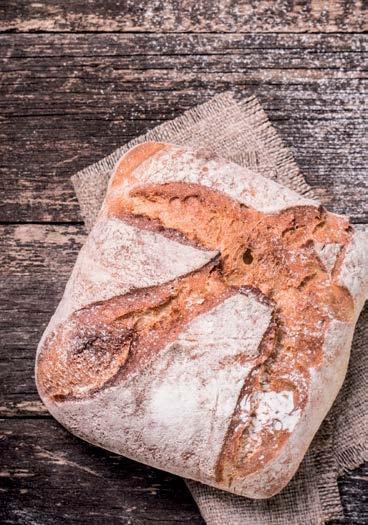 Bastian Borchfeld
Bastian Borchfeld
Would you like to know exactly why industry leaders count on CSB?

EDITORIAL
Your commments or suggestions are always appreciated: phone: +49
borchfeld@foodmultimedia.de ADVERTISEMENT www.csb.com
++ Bastian Borchfeld, Editor-in-Chief
40 39 90 12 28
Visit us! Hall 7.1 Booth B090 - C093
Control
06 Rademaker: Performance and flexibility
AIBI
12 Manchester : A successful AIBI Congress


Production
10 Haton: “We play in the Champions’ League”
16 Zeppelin Systems: “The ideal bun line”
BVT: Industrial Vacuum Cooling
“It`s important to understand the African market”
PUBLISHING COMPANY
f2m food multimedia gmbh Ehrenbergstr. 33
22767 Hamburg, Germany +49 40 39 90 12 27 www.foodmultimedia.de
PUBLISHER
Hildegard M. Keil +49 40 380 94 82 keil@foodmultimedia.de
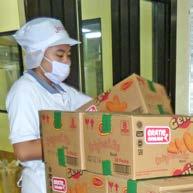
EDITOR-IN-CHIEF
Bastian Borchfeld +49 40 39 90 12 28 borchfeld@foodmultimedia.de
EDITORIAL STAFF
Helga Baumfalk +49 40 39 60 30 61 baumfalk@foodmultimedia.de
ADVERTISING DEPT.
International sales director Dirk Dixon +44 14 35 87 20 09 dixon@foodmultimedia.de
Advertisement administration
Susanne Carstens +49 40 38 61 67 94 carstens@foodmultimedia.de
DISTRIBUTION +49 40 39 90 12 27 vertrieb@foodmultimedia.de
TRANSLATION
Skript Fachübersetzungen Gerd Röser info@skript-translations.de
TYPESETTING
LANDMAGD in der Heide
Linda Langhagen; design@landmagd.de
PRINTED BY
Leinebergland Druck GmbH & Co. KG Industriestr. 2a, 31061 Alfeld (Leine), Germany
BAKING+BISCUIT INTERNATIONAL
is published six times a year. Single copies may be purchased for EUR 15.– per copy. Subscription rates are EUR 75.– for one year. Students (with valid certification of student status) will pay EUR 40.– (all rates including postage and handling, but without VAT).
Cancellation of subscription must be presented three month prior to the end of the subscription period in writing to the publishing company. Address subscriptions to the above stated distribution department. No claims will be accepted for not received or lost copies due to reasons being outside the responsibility of the publishing company. This magazine, including all articles and illustrations, is copyright protected. Any utilization beyond the tight limit set by the copyright act is subject to the publisher’s approval.
Online dispute resolution in accordance with Article 14 Para. 1 of the ODR-VO (European Online Dispute Resolution Regulation): The European Commission provides a platform for Online Dispute Resolution (OS), which you can find at http://ec.europa.eu/consumers/odr
Valid advertising price list: 2019
www.bakingbiscuit.com 04/2019 CONTENT 04 IMPRINT
cover photo: © Kwik Lok © f2m © Wasin Pummarin –123rf.com 20 44
26
38 Dimassaba:
40 MECATHERM:
42 König: One for all doughs 44 JADI ABADI: The Number 1
and Exhibitions
IBIE:
and Trays
Lhotellier R2A : All
35 Anneliese :
36 Precisma :
36 Kempf : A new coating Robotics 50 Schubert : Intelligent packaging Food Law 54 Meyer-Kretschmer: Acrylamide in bakery wares Regulars 03 Editorial 28 News 59 Trade fair calendar Insert König Maschinen Gesellschaft m.b.H., 8045 Graz/Austria © AIBI 12
The Baguette Factory
Fairs
20
A marketplace of innovation Pans
30 Bundy : Unrivaled Value, Quality and Innovation 32
about coatings 34 acs Coating Systems : Absolutely flat and warp-free
The most unusual shapes are possible
Compact, efficient, universally usable
Bake better product and improve oven throughput

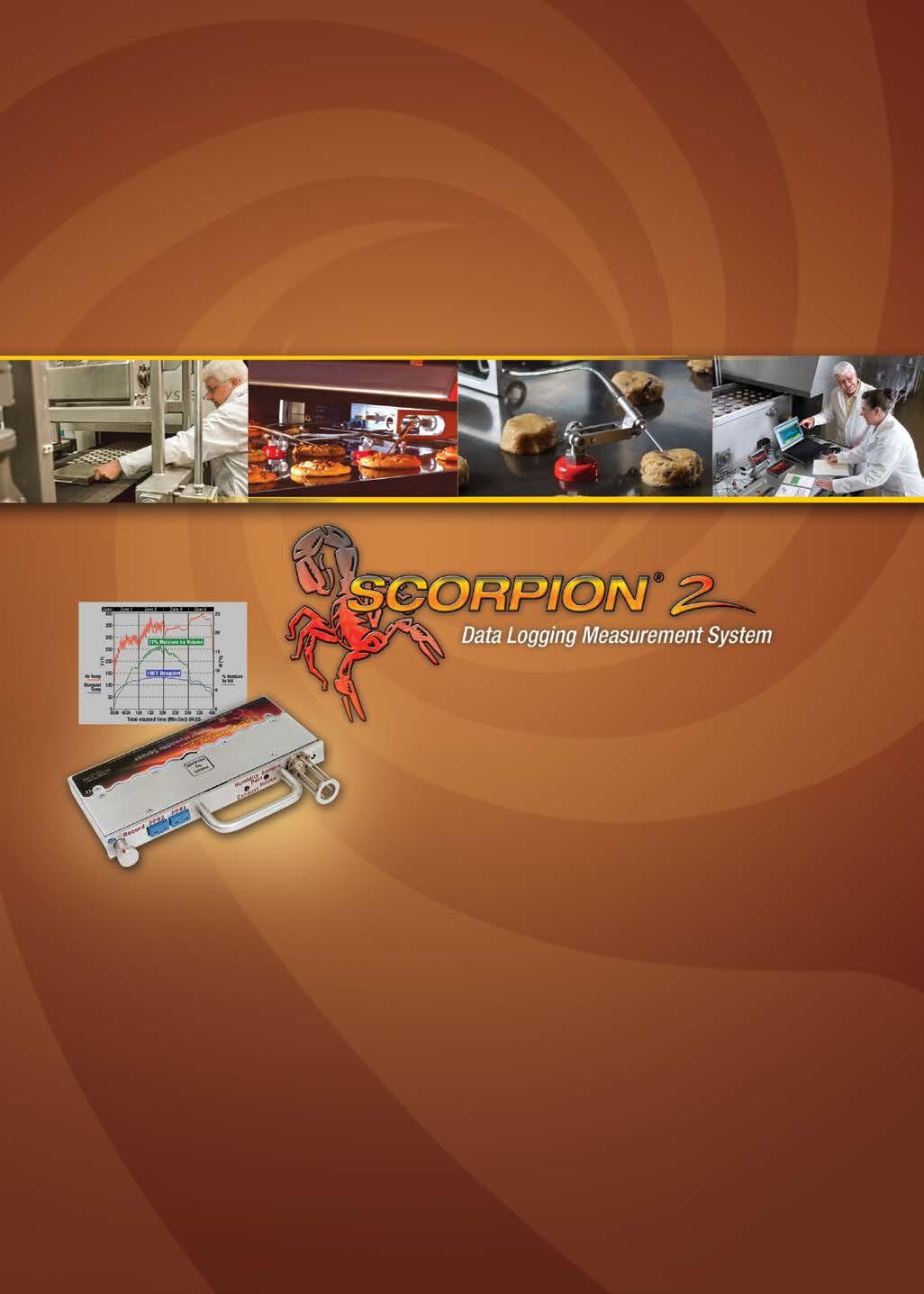
with the New
2 Digital Humidity Sensor
®
The new SCORPION 2 Digital Humidity Sensor provides a better way to measure humidity in your oven, proofer, dryer and cooling tunnel. This breakthrough design provides a more accurate and reliable way to measure the absolute moisture content of the thermal environment. The sensor contains a proprietary humidity sampling system with patent pending Anti-Saturation Technology™ that allows measurements in high temperature and very high dew point processes.
SCORPION®
For details,
us at info@readingthermal.com
ext. 2. Visit us at Booth 5521
visit readingthermal.com, e-mail
or call 610-678-5890
Performance and flexibility
Rademaker has developed a new pastry production line. The Universal Pastry Line with its newly-developed controller can produce a wide variety of dough pieces highly flexibly. Its construction is modular, and a well-thought-out tool concept ensures fast product changeover.
+Ability to perform meets quality – that’s the motto of the new generation of production lines from the bakery equipment manufacturer Rademaker. Specifically, it involves a newly-designed production line (Universal Pastry Line). The Netherlands-based company sees potential for the new line, which is designed for industrial operators and medium-sized companies, especially in the European and North American markets. That’s also why Rademaker is showing the machines at the IBIE trade fair in Las Vegas and the südback trade fair in Stuttgart.

Operation 24/7
Explaining the design concept of the new generation of production lines, Paul Groenewegen, Managing Director of Rademaker Germany (which also serves the Austrian and Swiss markets) says: “In their design, we took special care to ensure the production lines have very good accessibility to make cleaning and maintenance as simple and easy as possible, and we maintain the highest hygiene standards.” Stainless steel, smooth surfaces, a rounded frame and the use of materials approved by the FDA (U. S. Food & Drug Administration/ the US foodstuffs and medicines authority) guarantee that the machines are easy to clean. Paul Groenwegen goes on to explain that “The Universal Pastry Line has no recesses, cavities or dead zones, and it goes without saying that this new Rademaker production line is entirely designed and
approved for wet cleaning.” The belts are also equipped with quick-release devices, the belt tensioning rollers are massive, and all of the machine’s bearings are located externally. The machines are designed to operate 24/7. Moreover, due to the high in-house production ratio of around 94%, Rademaker also ensures that the customer’s high quality demands and a problem-free spare parts supply are guaranteed.
A new tool concept
When developing the production line, the designers considered it important to enable tool-free component and tool exchange. In the tool design concept for the latest generation of machines, each tool and every part of the machine has an individual identification number. According to Paul Groenewegen: “The tool assistant developed by Rademaker, which we call Tool Assistant, simplifies operating and retooling plants.” Tool Assistant stores individual tool and line configurations. Thus line settings are reproducible, e.g. when there is a product changeover, and users can understand and access them easily. All the line and tool data can be exported to the control panel or a tablet, or as a printout. Pop-up windows in the control panel explain to the plant operator which settings and process steps must be carried out. The control system is displayed on a 22-inch adjustable-height touch-panel. Access is password-protected, e.g. for recipe management, and there is also an option to access by chip.
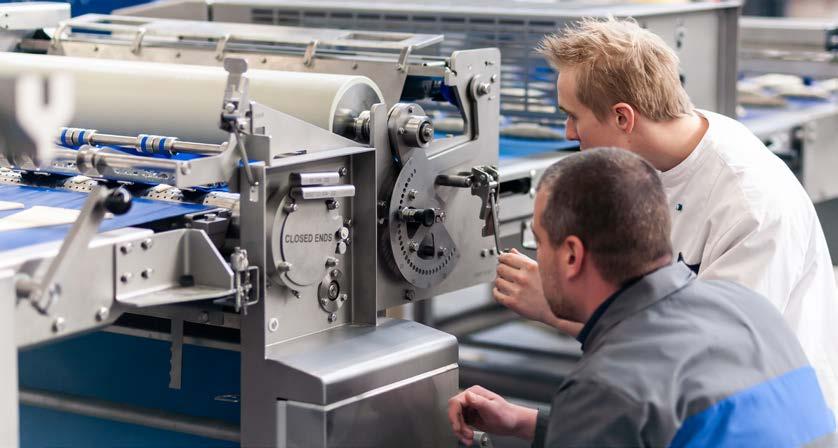
www.bakingbiscuit.com 04/2019 CONTROL 06
++ Low maintenance costs, energy-efficient drives, an Eco mode, robust plant construction compliant with an industry standard, long operating lives if maintenance is good, and a new, flexible tool system – these are the characteristic features of the new plants
© Rademaker
The new machine has fewer drives compared to other plants. Nowadays, instead of up to 20 motors/drives, only seven or eight per plant are needed. This is noticeable in the form of lower maintenance costs, for example. Users need to stock correspondingly fewer spare parts. As Groenewegen explains: “The subject of preventive maintenance plays an important role for Rademaker, so we prepare an individual kit of spare parts for each new plant, which the customer can keep in stock.”
Rademaker’s consistent emphasis on the “identical parts concept” in relation to spare parts also reduces the user’s stock-holding costs. Rademaker BV’s R&D Manager Jan van de Grift adds “We use standard components if it is possible for us to do so, but of course we add specific tools and designs to our machines in accordance with customers’ wishes. For us, this is a challenge we gladly accept.” Van de Grift played a key role in developing the new line concept, including implementation of the new controller. “We know how important an intuitive controller is in practical terms. It must be easily understandable, safe and secure. This is ensured by the novel cascade controller we have developed, e.g. with dough output (loop control) and dough input (DDIC) monitoring, together with a dough presence monitor,” explains Jan van de Grift. “This leads to improved product quality and greater operational reliability,” adds Paul Groenewegen because, for example, the new controller specifies which dough the operator must prepare and/or process next to make optimum use of the line, so the production facility will have the best possible capacity utilization.

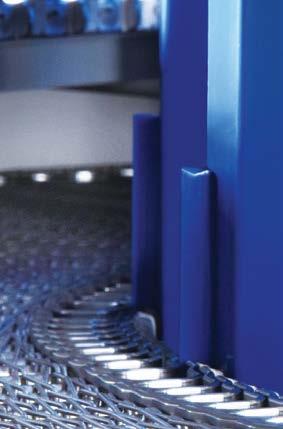
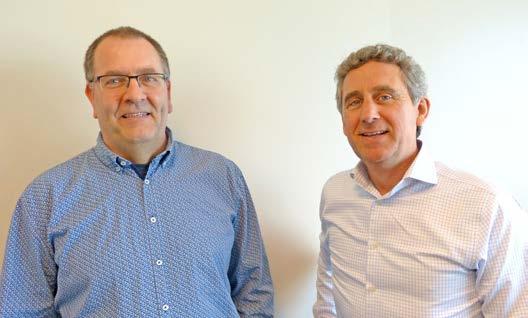
Flexibility
As Groenewegen explains: “Simplified operation, improved process control and lower maintenance costs compared to other models lead to a considerable reduction in operating costs, and support the efficient use of personnel.” Moreover, the cascade controller allows the production line to operate in sectional mode, or even automated modular operation, to increase the production facility’s flexibility. Thus the controller provides an increase in the machine’s capacity utilization, while simplifying operation at the same time.
The fact that the new Universal Pastry Line’s modules are interchangeable also makes this possible. Components such as the fat pump were also re-engineered. This enables different fats such as butter, margarine or clarified butterfats to be processed as needed. Horizontal and vertical screws with a molding function in the new, reengineered fat pump ensure a continuous flow of fat is applied to the dough sheet. Sensors supervise the process and ensure constant pressure
www.bakingbiscuit.com 04/2019 CONTROL ADVERTISEMENT
© f2m PosiDrive Spiral™ • High Tension
Heavy Loads
Greasy Products
Product Movement Proven Solution For: Call for System Audit +31 20 581 3220 www.ashworth.com Booth 5753
++ R&D Manager Jan van de Grift (l.) and Managing Director Paul Groenewegen
•
•
•
++ Each tool and machine component is given a name and a unique identification number. These allow a user to know which tool he/ she should use when there is a product changeover
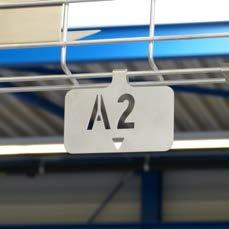
monitoring. The fat pump is also mobile and can be removed from the production unit, e.g. for cleaning. The designers also took care to ensure that the fat pump can be dismantled and cleaned easily. According to R&D Manager Jan van de Grift “We are also confident we have the most accurate fat pump on the market, and errors are less than 1%.”.
Fat pump data
+ Fat pressurizing is monitored by a sensor, thus preventing unwanted heat input, and lamination takes place more cleanly
+ The fat layer is applied across the entire working width without any dead corners (hygienic design) across a 270 mm width
+ Options to adjust the fat layer thickness of the applied fat layer (dough/butter ratio)
+ Accurate weights through minimal tolerances of below 1% – depending on fat type and temperature
+ Friendly cleaning opportunities through good accessibility to the entire fat pump
With the new production line, Rakemaker offers a choice between various different lamination methods to cater for customers’ requirements and requests. As Paul Groenewegen explains: “This is how we support customers to find the best lamination method, which depends on the required capacity and type of dough being used.” For example, the overlapping method is suitable for stable doughs (lamination width 600 mm). The horizontal lamination method is also an option for softer doughs (lamination width 600 to 1,600 mm), while the “cut-and-stack” method is the most flexible system with regard to the number of fat-dough layers, and can be used to laminate both rather firm and rather soft doughs. The lamination width when using these methods is between 600 and 1,600 mm.
++ Intuitive cascade control design allows the plant to operate sectionally, while an intelligent controller gives support during production, retooling and cleaning
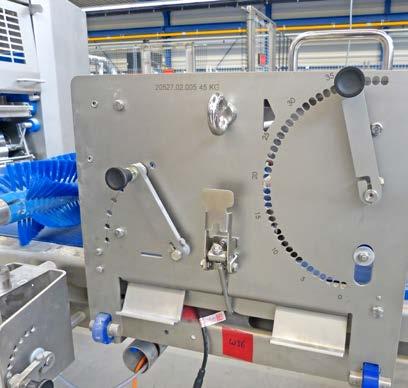
Rademaker laminators also allow a dough cooling and resting section to be installed. With the Universal Pastry Line, dough resting times up to 2.5 hours are achievable in this way. “The engineering and technology for this system were developed by Rademaker, and it builds them itself. A very large volume of experience and know-how in this area has been accumulated during the past approx. 30 years. The cooling process ensures that the dough and fat layers remain intact in laminated doughs. This leads to a considerable improvement during the downstream processing of the dough sheet,” according to Jan van de Grift. To which Paul Groenewegen adds “But even for products that are not laminated, the rest time ensures dough relaxation and thus the best possible flavor and a trend to larger baked product volumes.” In relation to the cooling and resting section, the new controller also calculates that the timing, i.e. time and belt speed, are optimally coordinated to one another in order to guarantee high capacity utilization.
Rademaker’s new Universal Pastry Line now enables (semi-) industrial and in-store bakeries to manufacture all kinds of baked and laminated products in any size and shape, filled or unfilled. Hourly capacity is from 350 to 1,500 kg of dough. The company says a significant reduction in operating cost is also possible. This is achieved by improvements such as efficient, error-free tool change, a low level of maintenance and simplified, intuitive operation. Moreover, Rademaker is confident that hygienic machine design has been raised to a new level. Modular construction also ensures flexibility, and single plant components, e.g. a mono-pump metering machine with an individual single-series controller is possible at the customer’s request. Furthermore, the new plant’s controller is undergoing further optimization, for example the flour dusters, which can be cleaned in a dishwasher, allow synchronization of the new pastry line plant to achieve a high output capacity and great production flexibility. +++
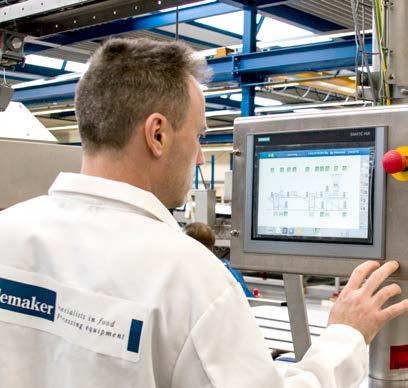
www.bakingbiscuit.com 04/2019 CONTROL 08
© f2m © Rademaker

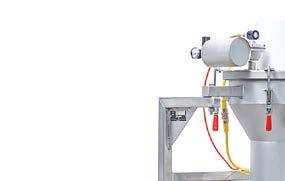
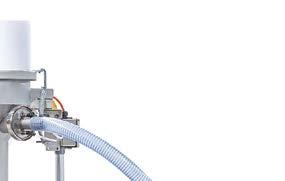

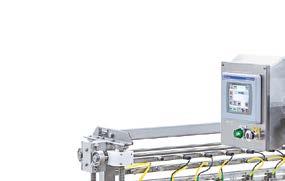
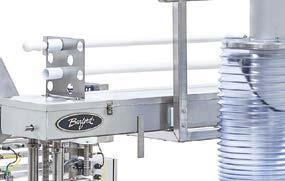
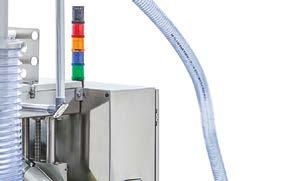
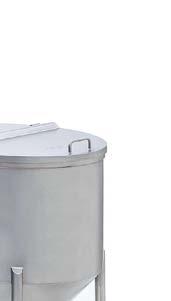
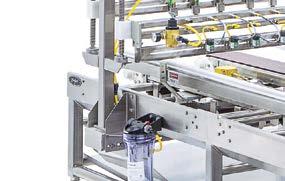
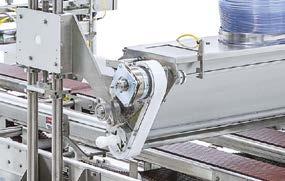
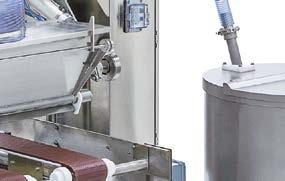


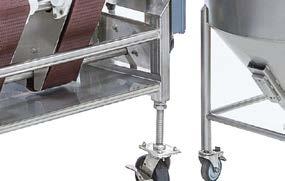
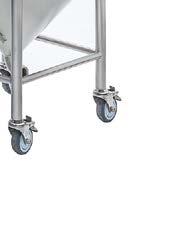





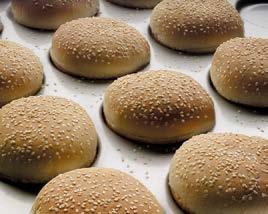

Right hand model 9840 shown with optional water spray, stacked water splitter, conveyor and MPA auto fill system. SMART SEEDER CALL US TODAY +44 1638 668563 THE TOPPING EXPERTS P.O. Box 748 • Maysville, OK 73057• Telephone (405) 867-4467 • Fax (405) 867-4219 • e-mail: sales@burford.com www.burford.com Unit 4 Sam Alper Court, Depot Road, Newmarket, Suffolk CB8 0GS UK • +44 1638 668563 • e-mail: sales@burford.com Booth 4803/4603
“We play in the Champions’ League”
WP-Haton concentrates on making up doughs by classical methods using dough dividers, rounders, long rollers and proofers. The focus is on excellence and flexibility.
The classical bread make-up method is called classical because it translates the advantages of traditional artisan work into modern technology. These include dough structure retention, shape stability up to the end product even with very soft doughs, and last but not least great flexibility regarding the doughs and weights that can be processed, and the baked products formed from them. Panningen thereby satisfies a global trend in the baked goods market that focuses increasingly on artisan quality and product diversity. The Crustica bread line, which on its own processes doughs with a water content of up to 80% of the flour used and a 12-hour dough resting time, yields more than 20 different products.
Hygiene and materials research are currently among Haton’s major lines of development. This has turned the basic dough divider solution into a wash-down solution in which individual components such as pistons, drums or conveyor belts etc. can be moved out of the machine and washed, and even the entire plant can be run and cleaned with water. It fulfills international protection standards for protection against water jets, and to some extent even against temporary immersion. For plants on which rye doughs containing sourdough are processed, the surfaces can additionally be designed to be significantly more acid-resistant than in the past. For example, Haton’s materials researchers are seeking a durable replacement for the Teflon coating in cones to eliminate the need for recoating processes.
Hygiene and new materials were also the headline for the Clean Proofers development that uses proofing baskets made from a novel plastic in large industrial intermediate proofers. The first of these plants are currently proving themselves in practical use, while the developers work on an automatic cleaning system. The current developments of long roller systems that allow the least possible pressure to act on the dough are aimed more at improving quality and efficiency.
The V 700 Industrial Dough Divider

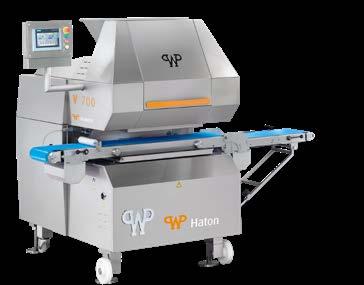
Weight accuracy: 99.5%
The V 700 is an example of the way Haton’s materials research developments have made their mark in the design of its machines. The V 700 is a dough-friendly volumetric dough divider. Dough piece weight accuracies of 99.5% are achievable. Thanks to new materials developments, it is now available both as a wash-down version and with acid-resistant units.
e V 700 is a dough-friendly volumetric dough divider with dough curacies of 99.5%
Panningen now earns 65% of its sales revenues outside Europe, and research & development suggestions originate correspondingly more often from other continents. For example, they include a decoseeder, initially requested by the American market, which strews toast-breads weighing up to 800 g all over with seeds, and does so at hourly rates of 4,000 to 5,000 pieces, depending on the proportion of grains. The idea has floated over to the Old Continent in the meantime, where it is being used for tinned breads made from rye mixed dough with a TA (dough hydration) of 175.
On the other hand, the Doughtwister has Asian roots. From the old 4-pieces method for toast-breads, it has created a
PRODUCTION 10
+
© Haton www.bakingbiscuit.com 04/2019 ++ C-Proof
© Haton
perforated stainless steel swing-trays
6-pieces version for small weights made from sweet doughs. Digitalization and automation are a third key development focus at Haton, although basically the cost-benefit question is in the foreground. Sales Director Rabi Williams says the meaningful aspect is “the communication between the dough divider and the checkweigher, but when it’s a question of controlling an entire line, we make sure trained operators are standing alongside the lines and have a technically qualified overview.” According to the expert: “We offer appropriate training courses where these are requested and
WP-Haton
Location: Panningen, The Netherlands
Production program:
Dividers: Rounders, Proofers, Molders

Even before the new millennium started, WP-Haton was one of the first bakery machine producers to organize their manufacture based on the Kaizen philosophy. Haton’s management has a flat structure. Divided up into regions, the Key Accounters, Project Accounters and Service Managers rank equally and work alongside and with one another under the CEO Henk Snellink.
in demand, and we also do so repeatedly in the event of staff turnover.”

Equally clearly and distinctly, Williams draws a clear line compared to other dough make-up systems such as dough sheet or extruder technologies. “We play in the Champions’ League and we concentrate on making further developments in our systems, e.g. by offering dough dividers with a 99.5% weight accuracy. That provides our customers with efficiency and flexibility.” +++


Around 700 exhibitors from 20 countries in six halls. Discover all the facets of the six main trade fair themes, find out about the diversity of topics and enjoy the atmosphere of a genuine trend and specialised trade fair for handcrafts. We look forward to seeing you!
südback – The trade fair for bakers and confectioners.
ADVERTISEMENT 11 PRODUCTION
++ Left: Axel Wagner, Key Account Manager, right: Rabi Williams, Marketing and Sales, Director Sales and Operations
the love of handcrafts. Fine. Finer. südback. 21. –
Messe Stuttgart www.suedback.com
© Haton © Haton
For
24.09.2019 |
A successful AIBI Congress
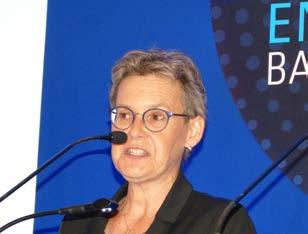

Approx. 200 baking sector representatives met together for the 36th AIBI Congress in Manchester. High-caliber speakers provided information about how experts envisage the bakery sector in the future, and what challenges will need to be overcome.
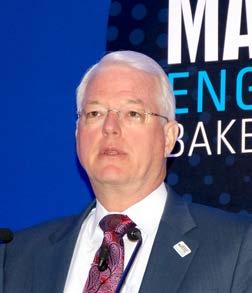

+A round 200 baking sector representatives from the whole of Europe and the USA met together for the 36th AIBI Congress in Manchester, England, from May 30 to June 2. High-caliber speakers, e.g. Ross Warburton, Executive Director of Warburtons, provided information about how bakery experts envisage the bakery sector in the future. There was also a discussion of the challenges facing the bakery sector, and how these can be overcome.
Ross Warburton explained that Warburtons Bakery is a private family company being actively managed by the fifth generation. According to the speaker, with around 4,500 employees in twelve production facilities and 14 depots throughout the whole of Great Britain, Warburtons is the country’s biggest family-managed bakery business. Its headquarters is in Bolton, and the bakery uses its own fleet of around 900 trucks to deliver its fresh products daily from depots and production units to approx. 18,500 customers. The baked goods are then sold in supermarkets. According to the speaker, Warburtons is considered to be Britain’s most popular bakery brand. The company generates annual sales revenues of around GBP 550 million. Ross Warburton dealt in detail with changes in the market.
For example, turnover with packaged, sliced sandwich bread has declined by 4% in the past four years. The turnover of bagels, for example, increased by 73% in the same period (compared to four years ago). Turnover grew with wraps (+67%) and bread rolls/buns (+7%). Warburton explained that “We must constantly adjust to changing consumption habits.” New players in the market, such as discounters and the growing offering of frozen baked products are changing the market. The responses available to bakeries could be to offer sandwich alternatives, for example, instead of “only” toast-bread. Ross Warburton also sees growth potential in the areas of “snacking” and “healthy baked products”. Warburton stressed that product life cycles are becoming altogether shorter. Therefore he says innovations and new products are important. That’s also why the company constantly invests in production facilities and in new plants.
Employee management
Another highlight was the presentation by Sir John Timpson, Chairman of Timpson, the British shoe repair chain, which has more than 2,000 shops throughout the country. The British businessman has a weekly management column in the


www.bakingbiscuit.com 04/2019 AIBI 12
++ Joseph Street, President of the AIBI from 2017 to 2019 (l.), Susanne Döring, General Secretary, and the new AIBI President Janez Bojc from Slovenia
++ The Lord Mayor of Manchester, Councilor Abid Latif Chohan
++ Sir John Timpson, Chairman of the shoe repair chain, gives a talk about “Magnificent service from magnificent staff”
++ Traveling from the USA especially for the occasion: Robb MacKie, CEO and President of the American Bakers Association. The expert supplied information about the North American bakery market
++ Ross Warburton, Executive Director, Warburtons, gives infor- mation about the bakery sector’s positioning in the market
© f2m ©
© f2m © f2m © f2m © f2m
++ Anne Fremaux, Bakery Director, Gira, presents new figures about the European baked goods market and highlights new trends in the baking sector
f2m
100 years of combined passion and know-how
With combined experience we enable you to produce the finest baked products
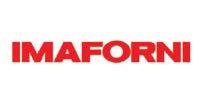
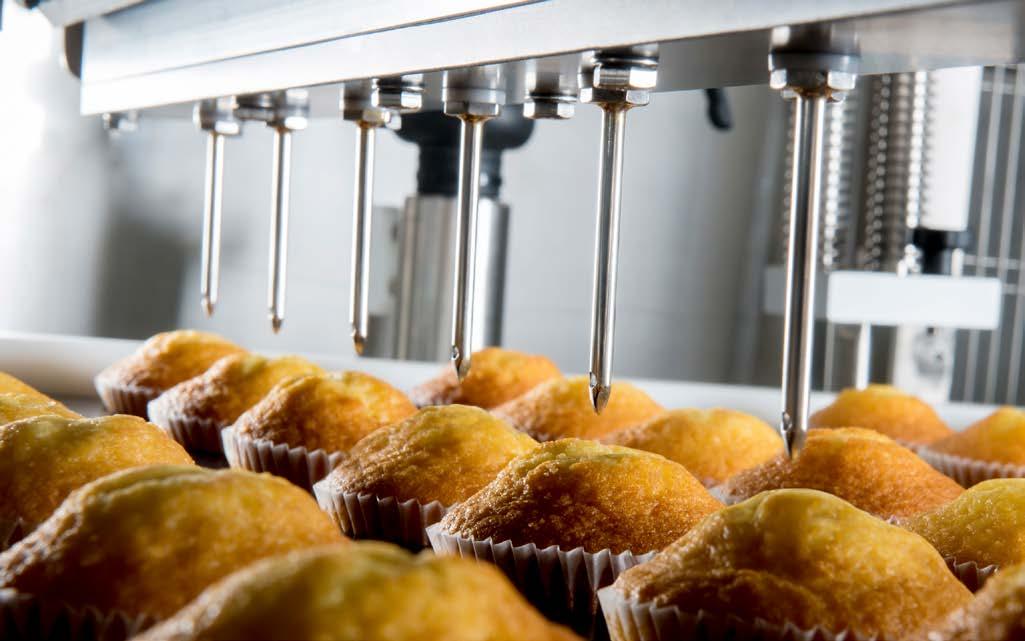
At IBIE in September, GEA Comas and GEA Imaforni will present durable solutions for the bakery industry built on 100 years of combined engineering knowhow coupled with fine craftsmanship. Our know-how extends to the development of new recipes by working together with our customers.
Meet with our experts to discuss your exact processing needs and explore how our GEA Bakery Experience Centers can bring your product ideas to life.
We look forward to meeting you at IBIE, booth 7547, in Las Vegas from September 8-11, 2019.
++ A historic double-decker bus took us to an evening event with live music to bring to a close the successful AIBI Congress in Manchester


newspaper “The Daily Telegraph”. Sir John has also written several books about his management style. For example, the employees in the shops should assume local responsibility and should take decisions themselves, e.g. about pricing. He says the price list for the various services is more like a guideline in this respect. What is important, however, is that money comes into the checkout. The task of management is to support the staff in the shops, including with private problems, for example. According to Sir John, employees should enjoy their work and should feel they are part of a family.
Trends
Anne Fremaux, Gira’s Bakery Director, presented new figures for the baked products market, and gave participants information about new trends in the European baking. For example, there is a rise in the consumption of baked products in the patisserie and Viennoiserie areas. But there is also growth in the areas of flatbreads, hamburger buns and donuts. On the other hand, according to the speaker, the trend in bread consumption is downwards. In the bread area, Anne Fremaux sees growth for premium baked goods, e.g. baked in a stone oven, and for “artisan-style” breads, i.e. baked goods that look as though they were “made by hand”. However,

“healthier” baked products with more dietary fiber or proteins, or breads enriched with spices or vegetables also offer opportunities for growth. The subjects of “Clean Label”, “Avoiding Refuse”, “Vegan” and “From the Region” are highly important to consumers.
New elections
In addition to the specialist presentations, new elections were also held. The members elected Janez Bojc, President of the Slovenian Federation, to be the new AIBI President. The new President thanked his predecessor Joseph Street for the latter’s activities and initiatives in the interests of European Industrial Bakers during his time in office. Bojc issued an invitation to Slovenia for the next AIBI Congress. The 37th AIBI Congress will take place in Bled from May 27 to 30, 2021.

Georg Heberer from Frankfurt was confirmed in his office as the President’s First Deputy. Armin Juncker, CEO of the Federation of German Industrial Bakeries, remains as Treasurer of the AIBI. The AIBI (International Association of Plant Bakers) represents the interests of large bakeries and supplies information for its members. More information at: www.aibi.eu +++
++ There was time between the specialist lectures to discuss the presentations




www.bakingbiscuit.com 04/2019 AIBI 14
© AIBI
© AIBI
© AIBI
© AIBI
© AIBI
© AIBI
© AIBI
Versatility Reliability Quality
VMI offers state-of-the-art mixing technologies to meet the varied requirements of the baking industry.
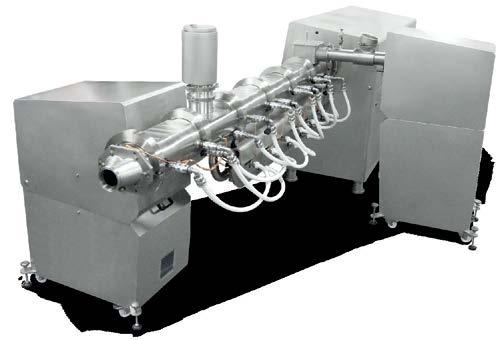

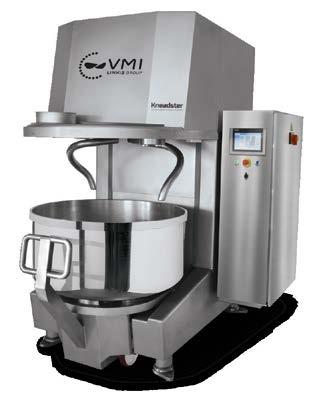
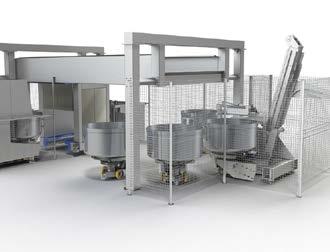
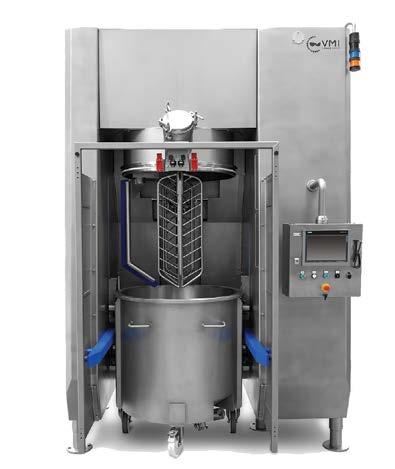
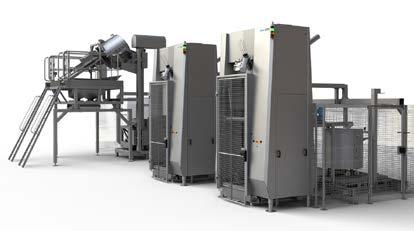
VMI is THE mixing company.
70 rue Anne de Bretagne, Saint-Hilaire-de-Loulay, 85600 Montaigu Vendée - France Tel. +33 (0)2 51 45 35 35 - contact@vmi.fr - vmimixing.com
MIXING SOLUTIONS for bread, pastries, cakes and snacking industries
ULTIMIX Planetary mixer
VISIT US BOOTH
ROBOTIZED MIXING SYSTEM with suspended shuttle
#6779
“The ideal bun line”
Consultant Thomas Ismar of Zeppelin Systems GmbH says: “We haven’t re-invented bun production, but we have made it more efficient and more flexible at the same time.”
+Flexibility already begins at the dough preparation stage. The line evolves around with a continuous mixing system from the CODOS ® series that can either supply straight dough or can also operate on the sponge& dough principle.
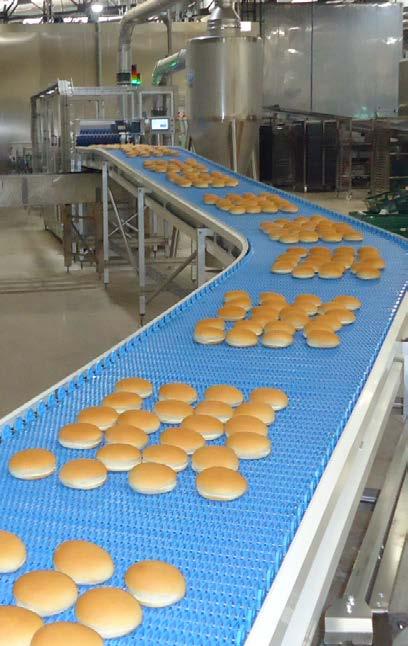
The CODOS ® , following more than 100 plants now in service in baked goods production worldwide, got an all-round makeover last year with new drive technology, new cooling, Washing in Place, and also a new controller that communicates with Zeppelin’s higher-level automation and digitization software. So Zeppelin created the new CODOS ® NT.
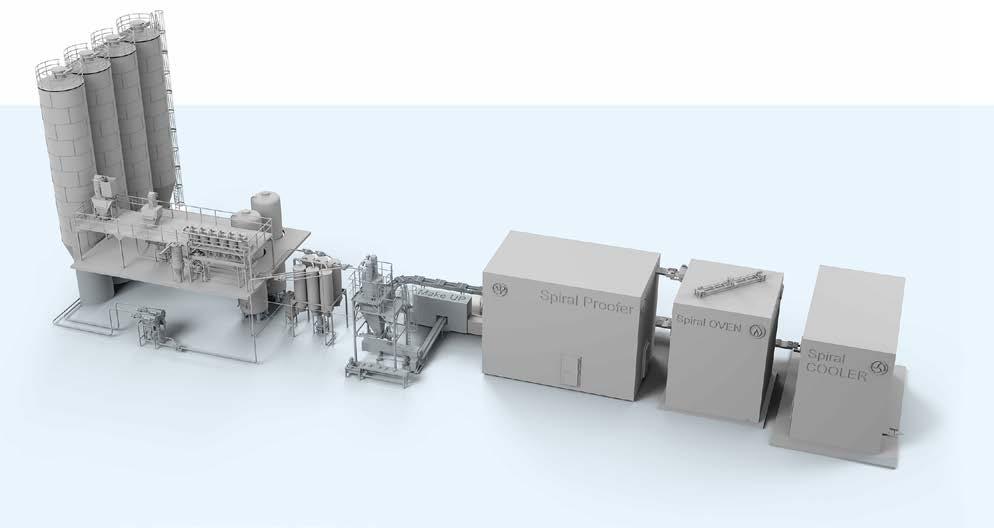
The previous asynchronous geared motor has been swapped for a water-cooled servo drive with a single reduction gear, which means not only a 40% weight saving but also a reduced installed length, i.e. space is saved, and on top of that energy consumption is reduced.
The cooling system of the CODOS ® NT has also been fully redesigned. The efficiency level of the trough cooling has been improved considerably, which ensures better heat transfer. All the trough cooling assemblies will be positioned outside of the new continuous mixer in future.
Moreover, with assistance from research work at the Cereals Research Institute IGV Foodtech in Rehbrücke, Germany, the geometry and spacing distances of the mixing tools themselves have been optimized again. According to Michael Piepenbrock, Zeppelin’s Business Unit Manager,
www.bakingbiscuit.com 04/2019 PRODUCTION 16
++ Zeppelin presented its version of the ideal toast-bread line at the iba 2018 trade fair. At the IBIE 2019 in Las Vegas, the talk is now all about the “ideal bun line”
© Zeppelin Systems
© Zeppelin Systems
The European Bakery Market 2019
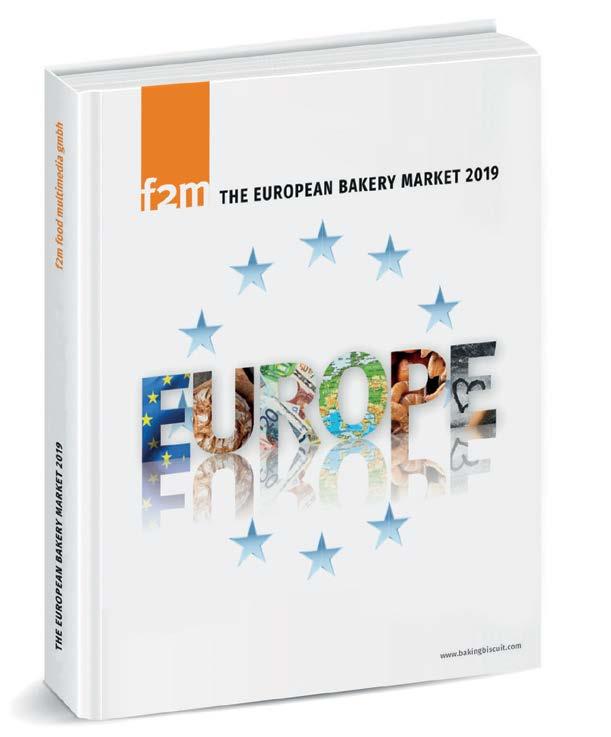
Please contact: Viktoria Usanova via E-mail: usanova@foodmultimedia.de
COnTENT
++ 7 Country portraits: Hungary, Poland, Romania, Slovakia, Sweden, Switzerland, United Kingdom
++ Expert Interviews: The European out-of-home market
++ Market Research: Trends and market dynamics
++ Company reports: Profiles of major suppliers to the bakery market
f2m food multimedia gmbh Ehrenbergstr. 33 · 22767 Hamburg · Germany · info@foodmultimedia.de Phone: +49 40 39 90 12 27 · Fax: +49 40 39 90 12 29 · www.foodmultimedia.de fotolia.com © lukiv007 Hard copy • 272 pages • EUR 49 incl. VAT + delivery costs For more information, please visit
Subscribe now to baking+biscuit international and you will get a digital copy of
book for free
our website: www.bakingbiscuit.com
the
new!
Food Processing Plants: “That provides more power and performance with less energy consumption, and makes the CODOS ® scalable.” There will be a CODOS ® NT 160 with a dough production capacity of approx. 3 tons/hour, the CODOS ® NT 200 at 4 - 5 tons/hour and the CODOS ® NT 230 with up to 8 tons/hour of dough. In 80% of all cases, a CODOS ® stage will be combined with a DymoMix that supplies pre-mixed, uniformly wetted raw materials to the CODOS ® . A two-stage CODOS® solution is usually used when processing flours containing extremely high gluten levels.
The sponge&dough principle involves installing conveyor belts between the sponge dough preparation stage and the final mixer, on which the sponge dough can rest and ferment while being conveyed, for up to 24 hours if required. The
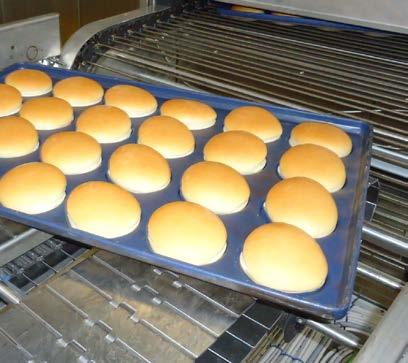
section can also be encased and air-conditioned if necessary. The layout being presented by Zeppelin in Las Vegas is based on a project in cooperation with well-known European manufacturers such as Handtmann, which is supplying the dough divider, and the Tecnopool Group, which is responsible
conveyor belt adjusts to the required resting time, and can accommodate up to 9 tons of dough. According to Ismar, four hours of fermentation are normally suggested for buns. A mixing capacity of 4 tons/hour of sponge&dough would need a transport unit 20 m long, 6 m high and 4 m wide. However, not only does the space requirement turn out to be modest, the investment budget for the fermentation stage also remains very manageable at EUR 0.5 million. Ismar says: “It’s probably the best value for money sponge&doughsolution of all.” Of course, the mixer and fermentation
for tray handling, the proofer, oven, cooling system and, if necessary, the freezer. Tecnopool specializes in spiral systems for all temperature ranges, and its developments include a novel thermo-oil-heated spiral oven in which hot oil circulates in pipes underneath the levels of the spiral. The construction of the spirals allows the pipes to run under one level and above the next, thus exposing the products being baked to radiant heat from both directions. The customer and/or the required production program decide whether the construction of the oven is circular or oval and whether the conveyor belt entry and exit are located at the top or bottom, as well as the oven’s height and thus the number of levels of spiral. The oven can be subdivided into temperature zones with separate oil circulations, to achieve a specific heat/time profile for a particular product. A heat exchanger positioned in the center of the oven and supplied from the hot oil system, together with a blower, provide convection heat if needed. A selection of various different steel rod belts is available to transport the baked goods, depending on whether baking is to take place directly on the belt, on trays or in pan clusters. According to Tecnopool, a combination of a spiral proofer, spiral oven and spiral cooler needs up to 600 m 2 less space than tunnel oven lines. +++
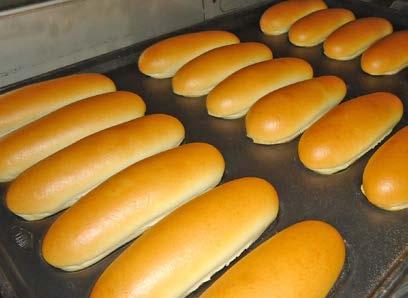
www.bakingbiscuit.com 04/2019 PRODUCTION 18
++ Layout for a bun line with an hourly capacity of 3,000 pieces per hour. The biggest line designed up to now delivers up to 60,000 buns/hr
© Zeppelin Systems
© Zeppelin Systems
© Zeppelin Systems
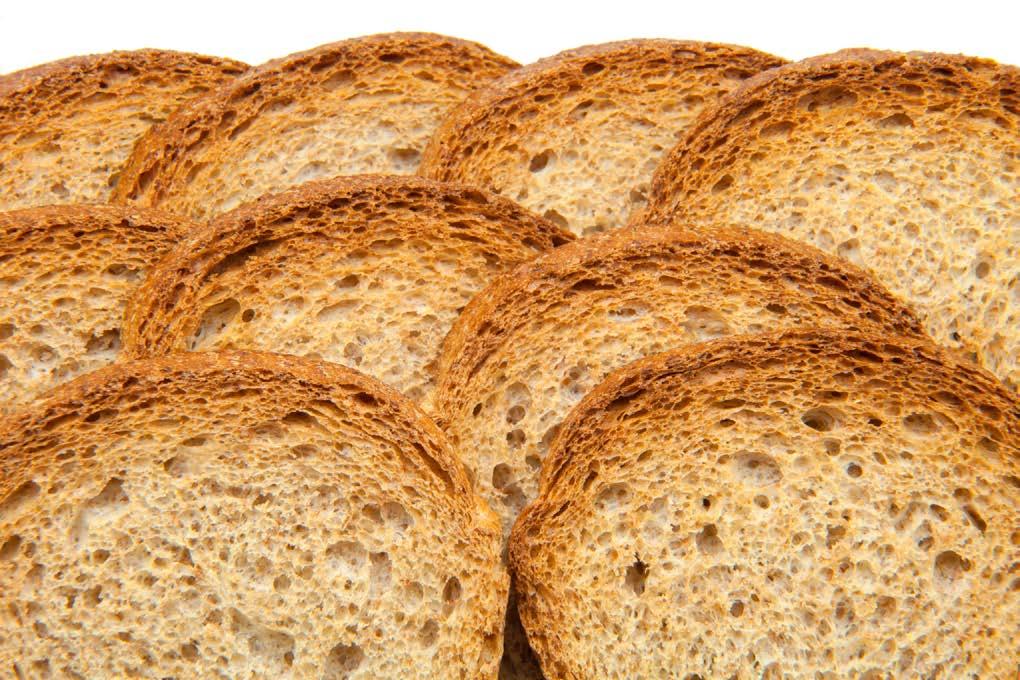
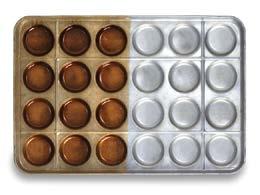
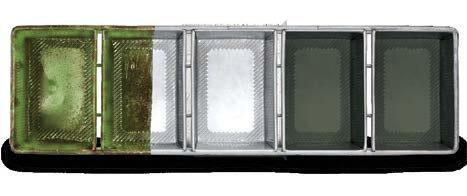
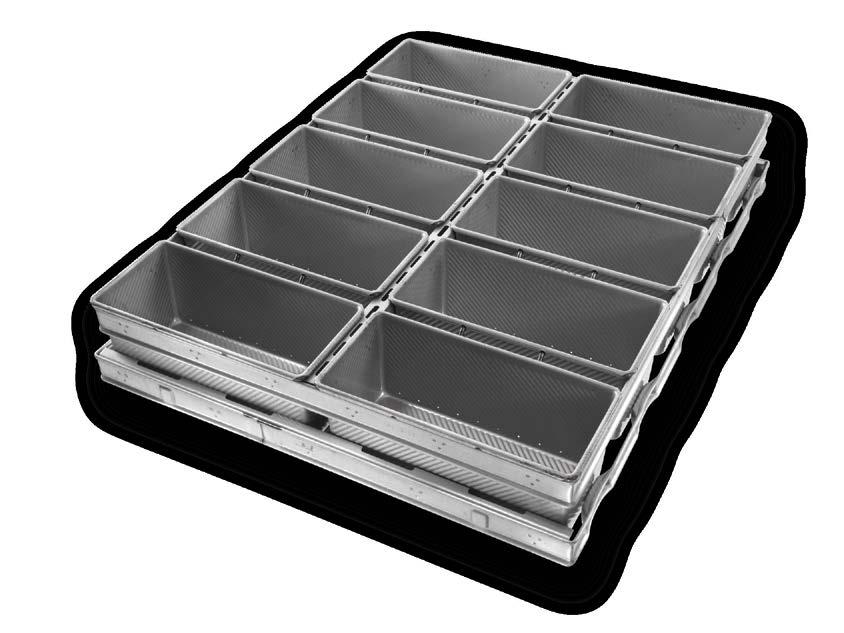
contact@americanpan.com | americanpancom For more than 30 years, American Pan has led the way in baking tin and tray innovation; from energy-saving designs to industry-leading coatings. We don’t believe in “one size fits all.” By engineering trays, applying exclusive coatings and providing economic refurbishment programs to fit your exact product and facility needs, we help you save money, increase quality, and outpace the competition. Bundy Baking Solutions: American Pan | Chicago Metallic | DuraShield | Pan Glo | RTB | Shaffer SKELMERSDALE, UK | +44 (0) 1695 50500 IRLAM, UK | +44 (0) 161 504 0771 THE PERFECT PAN from the first bake to the last. Contact our sales team to get started on your custom pan or cleaning program today. BARCELONA, SPAIN | +34 93 781 46 00 ALEXANDRIA, ROMANIA | +40 247 306170
Booth #5460
A marketplace of innovation
The IBIE 2019, International Baking Industry Exposition, will take place in Las Vegas from 8 to 11 September. On an area of approximately 65,032 m 2 more than 1,000 exhibitors will display products and services that pertain to the baking industry.
+According to the organizer, the IBIE is the largest trade show held in North America that showcases the industry’s latest technologies, equipment and new product introductions. Some companies have informed us in advance which innovations they will be presenting in Las Vegas.
All divisions of Bundy Baking Solutions will be present at IBIE 2019. Booth 5460 will showcase the latest products and technology from all of the companies. American Pan will feature a full range of custom baking pans including the newest large format bun pans, ePANs, TabLock trays, and trays for Mecatherm systems. The booth will also exhibit cake and bread pans in a variety of designs and the company’s proprietary coatings, including non-stick coating and silicone glaze. Information about the pan cleaning and recoating services will also be available. A full array of stock bakeware will be on display. These pans are shipped daily from Humboldt, Tennessee, USA to bakeries and foodservice operations throughout North America (for further information see page 30).
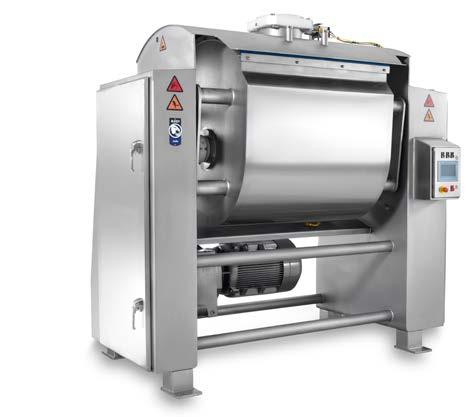

Shaffer will showcase multiple mixers and dough handling equipment, including the new Select Series Mixer line. Shaffer’s new Select Series Mixers are precisely engineered to offer maximum value and durability. The all stainless-steel construction combined with watertight enclosures and an open frame feature under the bowl, provides the ultimate mix of simple yet sanitary design. The mixer’s single end belt drive system and simple operator controls are comprised of well-known, commonly stocked components that make the
IBIE 2019 will take place
September 8-11, 2019 with a full day of IBIEducate on September 7 at the Las Vegas Convention Center. The trade show takes place every three years. It will span nearly 700,000 square feet (about 65,032 m 2) of space more than 1,000 exhibitors displaying products and services that pertain to the baking industry. The show is expected to draw more than 23,000 baking professionals.

Website: www.ibie2019.com +++
mixer easy to operate and maintain. The tilt system can be configured for forward only or forward and reverse tilting of the bowl. Select Series Mixers are available in triple roller bar or single sigma arm models to produce breads, buns, rolls, cookies, granola, and other baked goods. The Shaffer ® VerTech ® refrigeration jacket provides bakeries peak performance and efficiency, with the most effective, durable, and energy efficient bowl cooling available. The VerTech ® jacket is specifically designed for triple roller bar mixers that demand mixing durability; it easily holds up to stiff doughs and high horsepower machines without increasing mix time. In accelerated fatigue testing on a full-scale model, using over twice the force of a low absorption dough, the VerTech ® jacket showed no damage, even at over 40 times more cycles than other conventional jacket designs.
Shaffer continues to provide new, simple options for the sanitation of mixers. Schaffer’s agitator shaft seal design has progressed to include fewer parts leading to faster cleaning and superior leak prevention. The shaft seal design achieves superior sealing by applying exact pressure on the inner seal. This pressure forces the inner seal to expand and seal tightly to the agitator shaft preventing dough from leaking.
Shaffer’s new removable flour gate assembly is designed to be easily removed from the canopy to provide access for thorough cleaning of the assembly and area around the flour
www.bakingbiscuit.com 04/2019 FAIRS AND EXHIBITIONS 20
About IBIE
© Wasin Pummarin –123rf.com
++ Shaffer’s new Select Series Mixers are precisely engineered
© Bundy
gate. The assembly uses retained hand knobs that are integrated into the housing to provide tool-free removal in less than one minute and prevent the loss of hardware. Thorough sanitation of the flour gate assembly and surrounding area eliminates sources of allergen contamination and provides a clear check at a critical control point in sanitation evaluations. The assembly can even be retrofitted to existing mixers.
MECATHERM , Barembach/France, a world leader in automatic production lines for industrial bakeries, will be unveiling a brand-new flexible line concept. Raymond Nogael, VP Marketing, explains: "MECATHERM'S flexible line solution adapts to a new economic model with flexibility and agility, to replace the previous mass consumption reference model. Today, industrial bakery manufacturers need to be able to produce multiple products involving varied customized processes and need to launch products on the market quickly, without compromising on quality or performance". The new flexible production line, which will be launched during the IBIE 2019 trade show is the solution highlighted by MECATHERM to respond to this new demand. Smart and responsive, this new line provides the opportunity to supply a large range of products, produced using different process combinations with trays of varied types and formats. The latest MECATHERM technology and equipment, such



++ The new M-TA Oven fully redesigned allows a variety of heattransfer options from above and below






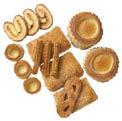



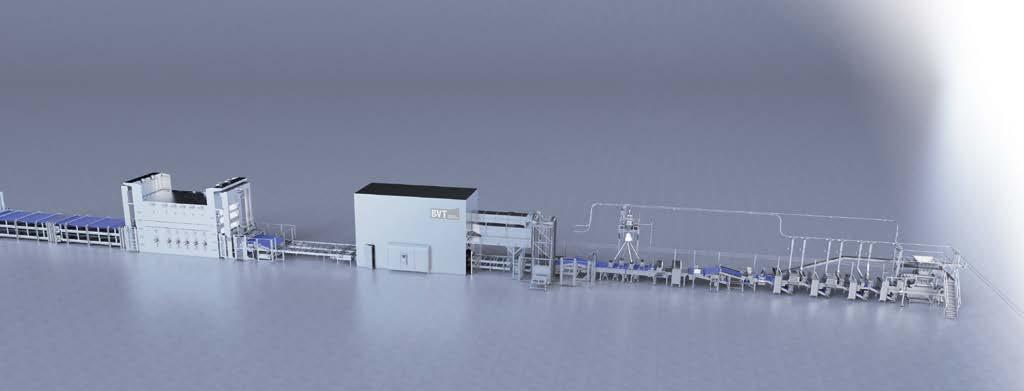
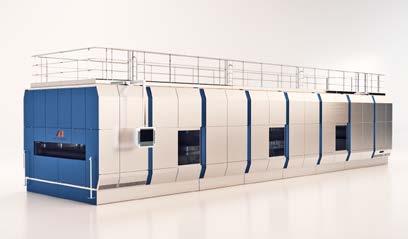
as the M-TA oven and the M-UB handling system unveiled during IBA 2018, will play a part in providing an innovative solution for industrial bakers. IBIE visitors can also attend demonstrations of the new M-NS divider at MECATHERM`s booth. This new make-up line has numerous advantages: its innovative technology produces authentic bread with a taste and shelf life adapted to current market demand.




Koenig Bakery Systems , Ashland/USA, will showcase its baking equipment at IBIE 2019. The very compact Mini Rex Multi dough divider and rounder features a new forming













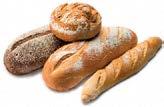

TOTAL DOUGH HANDLING
© MECATHERM

21 FAIRS AND EXHIBITIONS ADVERTISEMENT
BVT Bakery Services BV The Netherlands www.bvtbs.com
BOOTH 7189
station – it can now also produce Teleras & Bolillos. Bakers can easily insert various tools for producing the traditional Latin American breads, additional to products such as hot dog and hamburger buns and rolls with a plaited look, etc. The compact line has a capacity of up to 1,200 pieces per row/per hour and can also operate as a stand-alone machine with 1, 2, 3 or 4 rows.
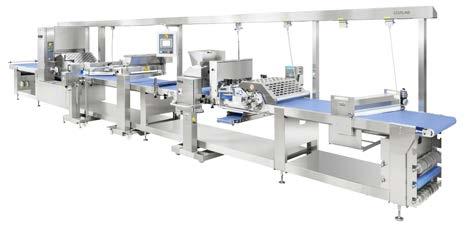
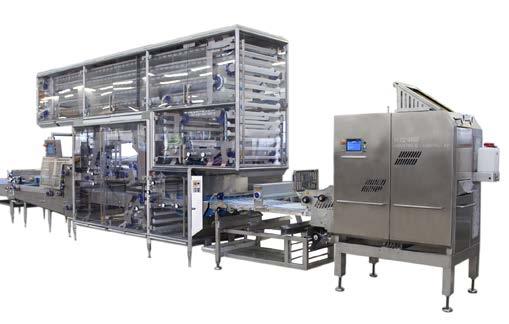
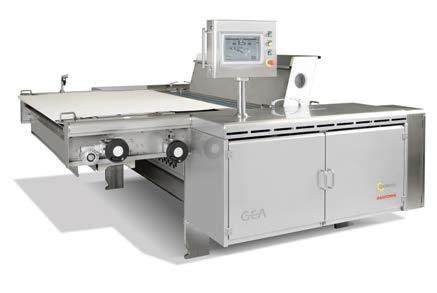
The Combiline plus EC is a modular roll line in “Easy Clean” design. Apart from its high versatility for producing various types of buns, the line provides easier cleaning, maintenance and access to all modules for minimized downtimes. The “plus” stands for an increased capacity of 33 strokes/min. for 11,880 pieces per hour with a 6-row operation. The line can produce various products such as hamburger and hot dog buns, decoratively stamped buns such as Kaiser, hoagies and half baguettes.
unparalleled performance combined with modern hygiene properties. The Starline adapts perfectly to baker’s needs and preferences and to the space requirements and work processes on-site in the bakery. It can be equipped with the advanced RONDO Control Concept, which makes operation simpler, faster and above all safer, even for non-skilled operators. The visualization includes the entire production line, so operation is intuitive and streamlined.
New developed system for bend croissants: Cromaster is a compact croissant system for an hourly output of between 4,000 (2-row production) and 24,000 croissants (8-row production) per hour. In addition to its compact and space-saving design, the Cromaster is characterized by high process reliability. The adjustable curling unit (patent pending) allows the production of both tightly and loosely curled croissants.
Under the motto, “100 years of combined passion and knowhow,” GEA will be exhibiting advanced bakery technology from its leading brands, GEA Comas and GEA Imaforni. Both processing and freezing technology will be represented at booth 7547.
Combiline plus EC
Easy cleaning and short changeover times are becoming increasingly important for bakeries of all sizes. Thus, the Combiline plus in “Easy Clean design” is comprehensively designed for easy and open access to all components. The “Easy Clean” concept features easily removable conveyor belts and flour dusters for cleaning purposes, and no tools are needed. In addition, all electric drive components are completely sealed off from the dough area. The proofing cabinet of the Combiline plus EC has been completely redesigned at a 45° angle, so that there is no soiling due to the sloping surfaces. The forming tools, e.g. for decorative stamping of dough pieces, are easily extracted and changed with quick-releasing methods and can be stored separately on their own accessory trolley. The line offers open design and has large service doors for easy accessibility to all modules. Furthermore, sensor systems ensure operator safety.
RONDO , the Swiss manufacturer of dough processing machines and systems, will be exhibiting many innovations and enhancements for artisanal, semi-industrial and industrial production at IBIE booth 5837. The company will show three different types of make-up lines, Starline, Polyline and Ecoline. The top model is the Starline, a user-friendly, robust make-up line boasting
Exhibits will include the high capacity GEA Rotary Molder for making soft dough cookies and shortbreads with different shapes and dough consistencies. Also on display, the GEA Multi-piston Depositor, which works with ovens up to three meters wide and boasts a host of innovative features that result in better products and higher productivity. As well in the spotlight, the GEA Paper Cup Denester, which places paper cups, aluminum foils and plastic containers for production of cupcakes, muffins, pies and layer cakes and operates at up to 50 cycles/minute. And throwing a little light on things will be the GEA TecLight, the new LED light option

www.bakingbiscuit.com 04/2019 FAIRS AND EXHIBITIONS 22
++ Easy cleaning and short changeover times:
© Koenig
© Rondo
++ The high-end make-up line Starline combines high performance with ease of use and ample space for accessories
© GEA
++ High capacity GEA Rotary Molder for making soft dough cookies and shortbreads with different shapes and dough consistencies

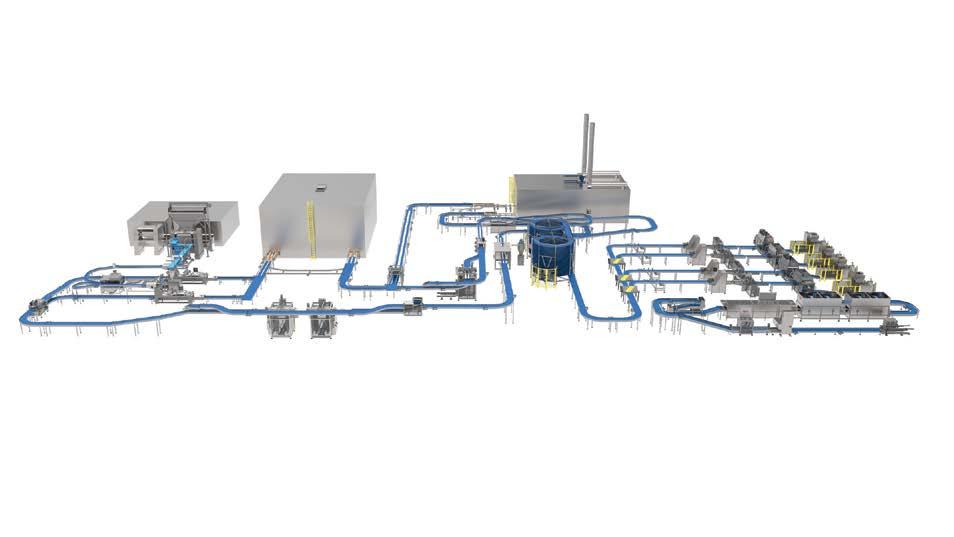

AMFBAKERY.COM | sales@amfbakery.com USA | Netherlands | UK | China | Singapore | Canada | Mexico | UAE MIXING | MAKEUP | BAKING | PACKAGING | POST-PACKAGING overall energy e ciency, or take your first step into automation, AMF’s Den Boer, Vesta, and BakeTech Baking Systems o er best-in-class equipment solutions with unparalleled support for the life of your bakery. Booth 5436/5420
from GEA, specifically developed for use under freezing conditions reaching -40 degrees Fahrenheit.
GEA experts will also present CALLIFREEZE®, a new freezer control system for GEA spiral freezers that continuously monitors the product’s level of frozenness to ensure that products are perfectly frozen without wasting energy; GEA A-Tec spiral freezers, which have been designed specifically for the North American market and featuring hygienic design, high product yield, fewer defrosts and low energy consumption; and GEA Packaging Solutions, including vertical form, fill seal and thermoforming systems that maintain food quality throughout the supply chain.
At booth 7469, Aasted , Farum/Denmark, will present a wide range of process technologies ranging from dough forming to adding value to products with chocolate decorations or enrobing. The exhibits also include the new Alice ™ II, the next generation of extruder as well as the Alice ™ High-speed wire cutter, which is even more refined, faster and easier to use.
Middleby Bakery will display some new developed technologies at IBIE this year.
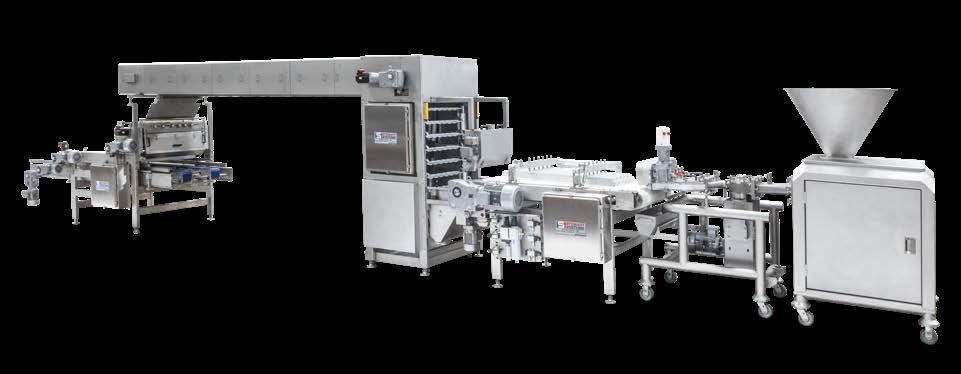

Auto-Bake Serpentine: Auto-Bake’s Dream Line can produce up to 1 million mini-bites per day in less than 20 meters with one line operator. According to the company it is the highest throughput in the smallest floor space in the industry.
Baker Thermal Solutions: The Templex Gen II Proofer offers a space-saving automatic proofing solution with the benefit of reduced maintenance based on the simplified new design. Burford is introducing three redesigned machines this year; The new Smart Pattern Splitter, the new 824 Spray Applicator and the new Enrober, with many added features to maximize accuracy and improve efficiency.
Glimek: Exclusively at IBIE, the Bread Line 450 produces up to 4500 pieces per hour. According to the company the IPP 1270 Intermediate Pocket Proofer is one of the most flexible pocket proofers on the market today.
Hinds-Bock: With the ever-increasing price of production floor space, Hinds-Bock develops equipment solutions that utilize minimal production space, while increasing and optimizing production throughput.
Scanico ’s Spiral Solution has been redesigned with direct drive and a hybrid plastic belt as integrated part of Middleby Bakery. The Controlled Air Cooling improves shelf life by filtering and controlling the cooling air.
Spooner Vicars will showcase the latest generation Rotary Moulder – the A-PEX Sport – and the new A-PEX Wirecutter. Both high speed applications, the A-PEX Sport is built to run at 40m/min, while the new Wirecutter is designed to run up to 300 cuts/min.
Features:
+ Easy to access the cutting mechanism
+ Fast changeover of wire cutter frame
+ Off-line function of complete extruder head gives easy access for cleaning and service
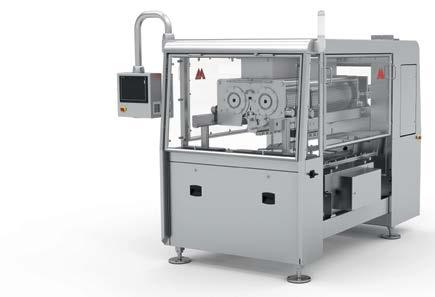
+ Fully adjustable cutting performance
+ Repeatable/adjustable parameters
+ Gentle dough extrusion with accurate weight control
+ Automatic clutch connection between head and drives
Stewart Systems will bring an 8-pocket Bun Make-Up Line with a fully updated Bun Divider, featuring individual pumpsand many other updates. The result is better weight accuracy and product consistency. Stewart’s Pillo-Pak will demonstrate new sealing technology in conjunction with MAP (Modified Atmosphere Packaging) Technology which will provide extended shelf life in a bulk format for QSR buns.
Sveba Dahlen will launch the new F500 F-Series Proofer –the proofing cabinet of the future – and Sveba Dahlen Connect that uses modern technology and connected ovens to increase your profitability and ensure the quality and consistency of your bread.
© Aasted ++ Aasted`s new Alice ™ High-speed wire cutter
FAIRS AND EXHIBITIONS 24
©
++ Stewart Systems’ High Speed Bun Make-up Line
Stewart Systems
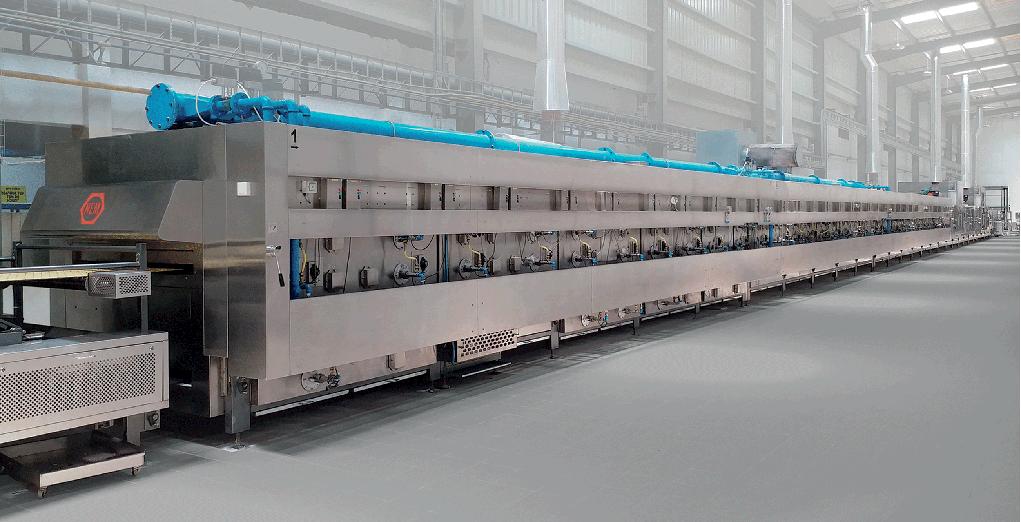





www.neweramachines.com sales@nem.co.in
Industrial Vacuum Cooling
Industrial Vacuum Cooling has been introduced to the market some years ago. One of the suppliers is the Dutch Verhoeven Bakery Equipment Family (BVT/NewCap/Vacuum Cooling & Baking Company). In the meantime this game-changing application has been appreciated on a worldwide scale.
The continuous -fully automated- system to cool baked products such as bread, toast, croissants, muffins, buns and rolls is part of the product range from the Dutch Verhoeven Bakery Equipment Family (BVT/NewCap/Vacuum Cooling & Baking Company).
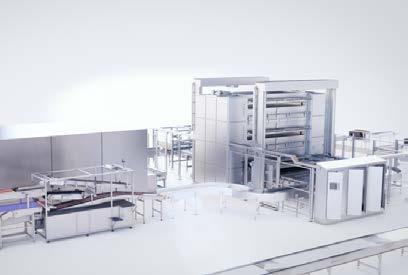
The development of processes like Vacuum Cooling opens up a whole new perspective for the market of food production. Although technically incorrect, the term ‘vacuum baking’ is often used in the bakery industry, implying the fact that the Vacuum process has great influence on the baking process. While the baking process can significantly be shortened, a different baking profile and baking curve arises.
The first continuous Vacuum Cooling systems have been installed at major Industrial bakeries over the world. By integration of this technique in the bakery production environment the average production capacity could be raised by 30-50%, because of the substantial reduction of the production time. Industrial Vacuum Cooling has now been applied for the production of standard baked products such as toast, biscuits and apple pies, but also for special products such as Gluten free. The implementation has resulted in substantial cost reduction and quality improvements.
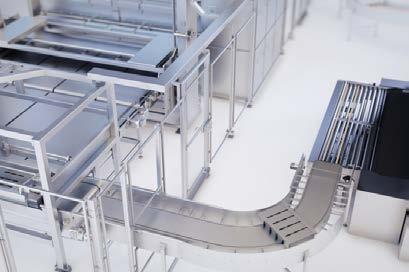
Most of these customers are continuously looking for a better quality of their product. But the investment is based on more than quality improvement alone. The scale of economics can be obtained by saving on space (the system is substantially smaller than a conventional cooling system) and on ingredients (the volume of the product is increased by Vacuum Cooling). Furthermore the reduction of the ecological footprint is supported by a massive decrease of the huge energy consumption
++ A vacuum cooling system is shown. This 25 m2 system could replace a traditional 250 m2 spiral cooler. Nevertheless the size of the vacuum cooling system is product dependent.
which is an important characteristic and one of the future challenges for the bakery industry.
The continuous Vacuum Cooling Process is much less time consuming than the conventional one. The modular designed installation is compact. The cells are stackable and can swiftly be loaded and unloaded. The ingenious operating system allows a rapid, partly pulsing increase and a controlled decrease of the vacuum. The Vacuum Cooling process enables a high capacity of production. The room capacity is customised and modified to the conventional oven production requirements. The system can be scaled up to quantities of 45.000 cakes, 54.000 croissants or 12.000 toast breads per hour, depending on the capacity of the preceding production line, the recipes and baking processes.
Author
Patrick Duss is an expert in vacuum cooling. The trained baker and confectione is also a studied business economist. He comes from a family of four generations of bakers. He has been involved in vacuum cooling technology for over 15 years. Duss is part of the V-team within the Vacuum Cooling & Baking Company. This team, within the Verhoeven Bakery Equipment Family, consisting of specialists within vacuum technology which focus on development, manufacture and implementation of vacuum systems in the baking industry
Vacuum Cooling & Baking Company
Parallelweg 13, 5349 AD, Oss, The Netherlands info@vacuumcooling.com, www.vacuumcooling.com
PRODUCTION 26
+
©
www.bakingbiscuit.com 04/2019
++ When the products come out of the oven it is important that they are placed in the vacuum cooling system as soon as possible. There is need for a quick supply.
BVT © BVT
The average cooling time for the products is reduced to 2-3 minutes instead of 60-90 minutes. At the production of Zwieback Toast, the maturing time of up to 24 hours can even completely be abolished.
Next to the production of batch chambers for bakery products the Dutch company offers tailor made Vacuum Cooling solutions for the production of other product like sauces, soups and fillings, tailored to the recipes and production requirements. The systems are wanted because they are suitable for versatile applications which allows the use for a variety of products.
The operating system forms the heart of the process and system. The product quality can be maximised and an increase of the volume can be realised due to a substantial reduction of the baking time. While the product is still dynamic the product quality is influenced and the capacity of the oven can be increased with 25-40%.
The Vacuum cells are closed and therefor the heat loss which occurs in the conventional cooling process, can be efficiently regained through heat exchangers. The existing temperature and condition of the production rooms is much less influenced by the baking process.
TINSETS
+ the right shape for everybody
+ for all trolleys and industrial lines
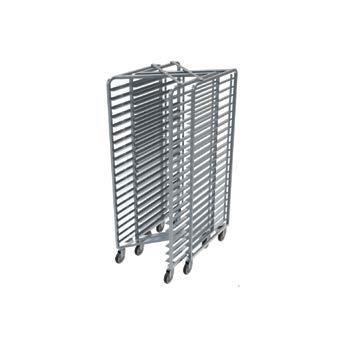
+ coatings for any type of dough
ZTROLLEYS
Make the most of your bakery

+ super stable
+ safe up to 66% of space



+ available for any tray size
TRAYS
Our trays can be used anywhere, both in the bakery and showroom. Any dimension and functional coating is possible.
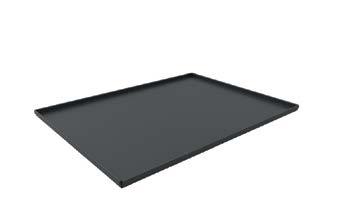
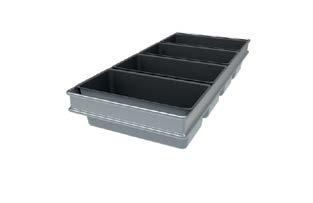
++ On the left a bread loaf is shown that was baked and cooled with the vacuum cooling system. On the right a bread loaf is shown that was baked and cooled the traditional way.
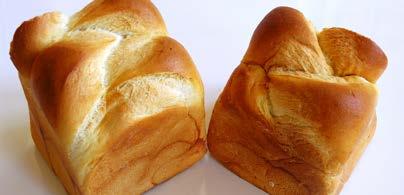
The baked product is stabilised due to the vacuum cooling process, and will lose practically no moisture (less than 4% sometimes down to 2,5%) compared to the conventional products.
Vacuum Cooling influences the distribution of the moisture, which leads to energy saving. On freezing time for instance a 30% saving can be realised. At the same time the physical characteristics like the crust can be improved and controlled. The baker steers the process in a detailed way, resulting in a better product with less Acrylamide and other unwanted compounds. +++
HIGH QUALITY THAT MATCHES YOURS

We are a well-known German producer of bakery equipment















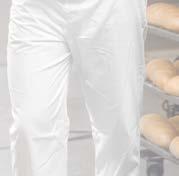


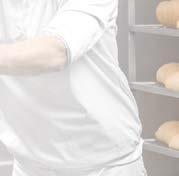






+ Baguette and mould trays
+ Racks and baking trays
+ Tin-sets
+ Coating and Recoating
ADVERTISEMENT 27 PRODUCTION
© BVT Visit us at Südback Hall 5 Booth D58 or at www.anneliese.com MADE IN GERMANY In der Krause 67, 52249 Eschweiler +49 (2403) 7001 0
@
uksales@anneliese.com
++ Ashworth’s New Website
Ashworth Bros., Inc., headquartered in Winchester, Virginia/ USA, has launched a new, mobile-friendly website. Customers and prospects can readily access comprehensive product information to help them select the right belt for their specific requirements. The easy to navigate design offers seamless browsing for users and provides enhanced visibility of new products and services. By simply clicking on product photos, users can find information on features, benefits, and specifications for a wide range of processing applications.
++ Sale of Bosch Packaging Technology
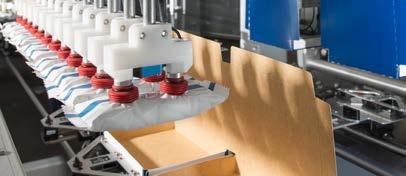
at Koelnmesse, who in turn will be developing the leading international trade fair for photography, video and imaging as a global platform for the industry. +++
++ Vincent Langelaar is the new General Manager for AMF Tromp

AMF Bakery Systems, Gorinchem, The Netherlands, announced that Vincent Langelaar has joined the Company as General Manager for AMF Tromp. “We are proud to have Vincent on board,” mentioned Fabiano Malara, Vice President and General Manager for AMF Europe. “With his proven industry experience developed over years of consultancy, business ownership, and senior positions with other equipment suppliers, he will guide the organization to a higher level of customer service and best-in-class technology.” +++
++ Tremaine Hartranft Named Director of Technical Sales at Reading Bakery Systems

Bosch plans to sell its packaging machinery business, based in Waiblingen, to a newly incorporated entity managed by CVC Capital Partners (CVC). The company and its Pharma and Food units will remain intact. Based in Luxemburg, CVC is a leading private equity and investment advisory firm with 24 offices in Europe, Asia, and the United States. It currently manages more than US$75 billion of assets. The parties signed an agreement on July 11, 2019 effecting the transfer of the entire packaging technology business and its 6,100 associates in 15 countries. +++
++ Spooner Vicars appointed David Hamilton as new Sales Director

Spooner Vicars announced the appointment of David Hamilton as Sales Director. David Hamilton is well known within the industry and has held numerous appointments, most recently as General Manager/Director of Silcoms, an Industrial Chain Manufacturer and supplier to the Bakery Industry. According to the company he has an in depth knowledge of the products having spent the majority of his working life at Spooner Vicars where he spent his career in sales, project management and engineering, eventually ending his tenure with the company as Operations Director. David will be based out of the companies premises in Golborne, Wigan, UK. +++
++ New Director of yummex Middle East
Koelnmesse has named Jan Philipp Hartmann (35) as the new Director of yummex Middle East (29 to 31 October 2019 in Dubai). His responsibilities include further strengthening the confectionery trade fair as a platform for innovation in the entire Middle East & North Africa region. Hartmann is replacing Fabian Ströter, the new Director of photokina
Tremaine Hartranft of Reading Bakery Systems (RBS), one of the world’s leading manufacturers of snack production systems, has been promoted to Director of Technical Sales, effective immediately. “We are very excited to welcome Tremaine and the wealth of technical expertise that he brings to our sales team,” said Shawn Moye, Vice President of Sales at RBS. Hartranft started with RBS in May of 2005 and held positions of increasing responsibility including Applications Designer, Project Engineer and Director of Engineering. In his new role, Hartranft will be responsible for the technical sales group, project management group and applications group. Along with these responsibilities, he will assist the growing RBS worldwide sales team, and support customer visits to the states. Working at RBS headquarters, he will also be the liaison between the sales and engineering departments, assuring a smooth transition for all projects. +++
++ Reading Bakery Systems Selects Meng Yeong Chong as Sales Manager for China
As part of its continuing expansion into South East Asia and China, Reading Bakery Systems (RBS) announced that Meng Yeong Chong has joined the company as sales manager for China. Meng will report to David Kuipers, Senior Vice President of Sales and Marketing for RBS. Before joining RBS, Meng worked in sales engineering and sales with Andritz, a large Austrian company with businesses covering hydropower equipment, pulp and paper processing, metal processing and separation technologies. He also worked for Heinkel, a privately held company based in Germany looking to expand their footprint in Asia. +++

www.bakingbiscuit.com 04/2019 NEWS ++ NEWS ++ NEWS 28
+++
++ Vincent Langelaar
© AMF Bakery Systems
++ David Hamilton
© Spooner Vicars
++ Meng Yeong Chong
© RBS
++ Tremaine Hartranft
© RBS
© Bosch
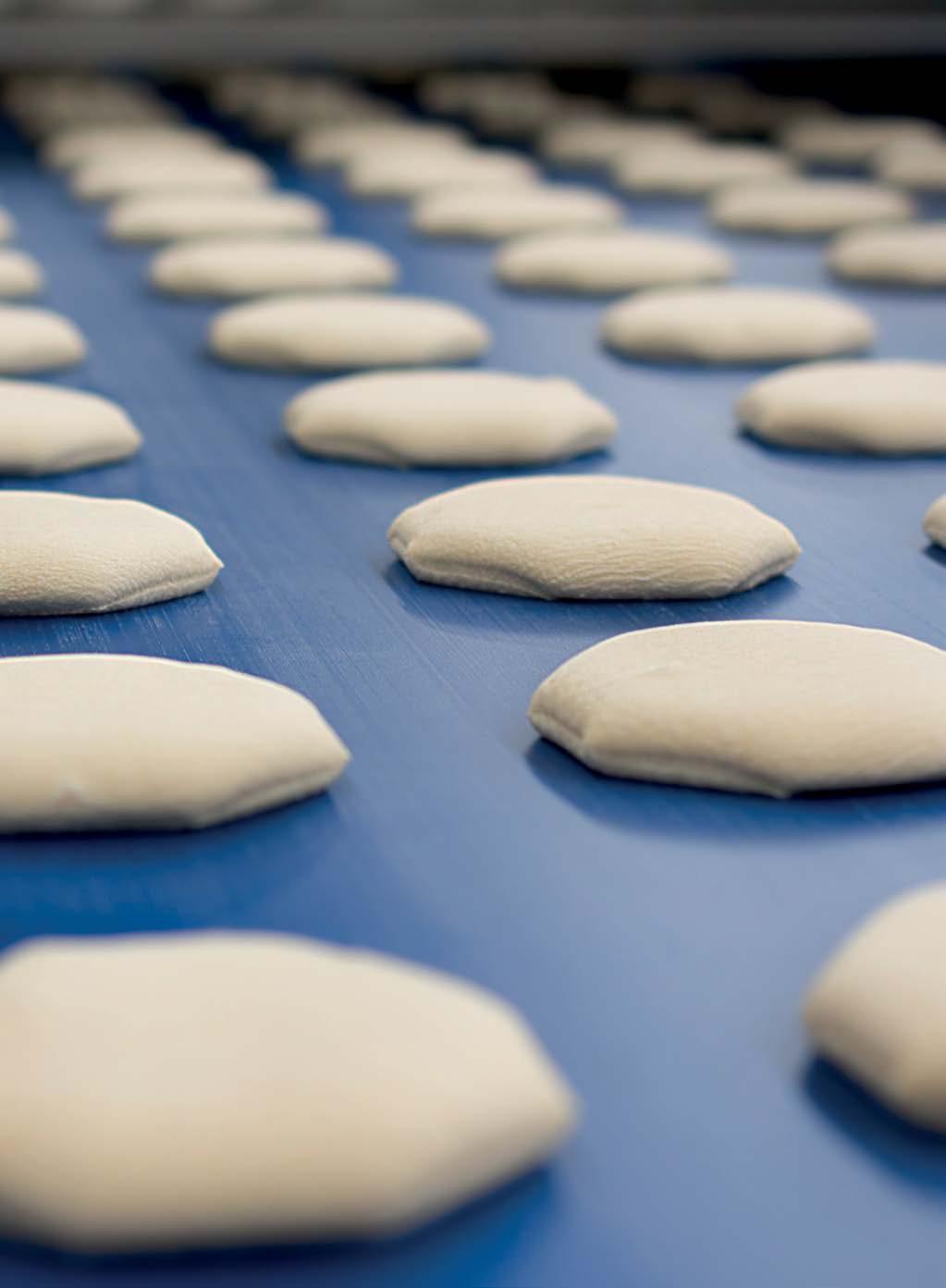


Specialists in food processing equipment www.rademaker.com Consistent Quality, Efficiency, Profitability Customers demand the highest quality bakery products delivered on time and at the right price. Rademaker understands these challenges. We provide efficient bakery equipment for every possible production environment, based on your specific dough processes and product requirements. Resulting in the lowest cost of ownership in the market yielding maximal results in terms of product quality and return on investment. Meet us at: Booth 5861 Booth 5C42
Unrivaled Value, Quality and Innovation
The Bundy Baking Solutions family of companies has been providing the baking industry with quality, innovative solutions for over 50 years ranging from custom baking pans and recoating services to state-of-the-art mixing technology.
+American Pan continues to make investments in equipment, tooling, and talent on a global level to ensure that the highest quality standards are met. The company has five manufacturing plants including one in Romania, one in South America, and three in the United States. These operations provide customers with options to meet their specific product, timeline, and budget needs while providing the consistent quality and service that they need and deserve.
Energy Efficiency with ePAN Designs
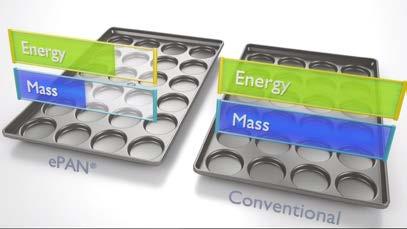
Available in any size or configuration, ePANs are made from aluminized steel with a specially designed framework called an e-band. The ePAN is around 50 % lighter than a traditional pan and offers numerous advantages to the baking industry. It requires less power to move it around a baking operation, less energy to heat up, and less time to cool down. Stronger than standard pans, ePANs can be stacked higher and therefore require less storage space.
Economical Screen Replacement Design
Another pan made with groundbreaking technology from American Pan is the TabLock Baking Screen. This pan features a fastening system for the baking screen that does not use rivets and does not require a drill for removal and replacement. The fastening system uses an engineered tab on the screen that locks into the tray frame using a proprietary hand tool.
Another feature is the quick and easy removal of the screen using another specially designed hand tool; this means that screens can be replaced in the bakery rather than having to be shipped to a service center, saving bakeries time and money.
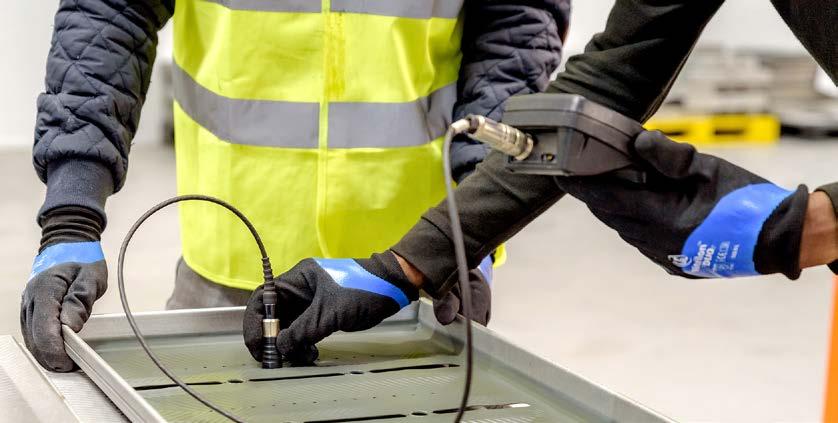
Best-in-Class Pan Coatings
American Pan offers a full range of proprietary pan coatings including both silicone-based and fluoropolymer coatings which have all been specifically formulated for baking to provide the most effective release of baked products. Available on new and refurbished pans, these coatings consistently
www.bakingbiscuit.com 04/2019 PANS AND TRAYS 30
© Bundy
++ The ePAN is around 50 % lighter than traditional pans and requires less energy
© Bundy
deliver more releases, sometimes twice the number of releases, than all other competitors worldwide. With their extensive recoating facilities and life cycle programs, they provide bakeries with a cost-effective solution to baking pan management.
AMERICOAT ® , the clear silicone glaze from American Pan has been proven to provide up to 30% more releases than all other silicone glazes. The coating reduces staining, minimizes labor costs, and cuts pan oil usage by up to 50%.
FlexiCoat is a rubberized silicone coating that is a popular choice for coating baguette pans, baking screens, and other perforated trays to provide specific baking characteristics and consistent quality.

American Pan’s DuraShield® fluoropolymer coatings provide bakers with a long-lasting coating that provides an excellent release of baked goods. With a minimum of 3,000 releases guaranteed on most products and over 5,000 releases documented at some of the world’s leading bun bakeries, Dura Shield ® provides the world’s longest release life. DuraShield ® is certified to be PFOA-free and offers improved sanitation with complete elimination of oil usage.
OptiShield ® fluoropolymer coatings have been developed to provide a durable solution for conditions where a standard coating will not perform. Whether it is an extremely sticky dough or extreme temperatures, American Pan has a formulation that will work for your operation.
The Value of Pan Refurbishment

Pan refurbishment services from American Pan increase the life of pans at a fraction of the cost when compared with those associated with purchasing new pans and help to keep pans in optimal condition during their use.
American Pan currently has four pan refurbishment locations throughout Europe, including one in Romania, one in Spain, and two in the UK.
All pan refurbishment operations use the same proprietary method of cleaning and recoating, which has been refined and perfected over five decades of hands-on experience. The system has been designed to quickly and efficiently remove old coatings, carbon, and greases from baking pans following which the pans are coated with DuraShield, OptiShield, AMERICOAT, or FlexiCoat. After being recoated, the pans are delivered back to the bakery ready for use in production. This process has been proven to significantly extend pan life and decrease or eliminate the use of release agents.
Providing Better Pan and Bakery Management

In today’s competitive manufacturing environment, bakeries rely on technology that allows them to visualize every aspect of the production process and eliminate inefficiencies. Analytics received using American Pan’s SMART Pan
Tracking® system provides bakeries with data to monitor pan coating life and line efficiency.
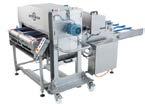
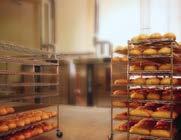


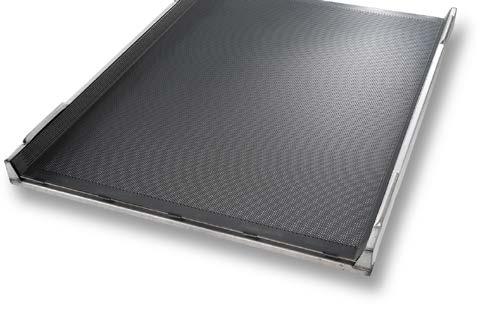
The SMART Pan Tracking system begins with American Pan’s uniquely encoded pans that are laser etched with a 2D code and pan number. The code and number are linked to a database specific to each bakery that includes information such as pan type, dimensions, mould size, coating life expectancy, and the number of bake cycles on the pan. Sensing technology is incorporated into the bakery’s production line to scan each pan and feed data to a secure website.
The system can even identify ways to improve a bakery’s line efficiency, such as monitoring and reducing the number and duration of gaps between pans – thus identifying “missed opportunities” for maximizing throughput on high-speed baking operations. +++

31 PANS AND TRAYS www.bakingbiscuit.com 04/2019
KOENIG BACKMITTELGMBH & CO. KG • Postfach 1453 • D-59444 Werl Tel. 02922/9753-0 • Fax 02922/9753-99 E-Mail: info@koenig-backmittel.de Internet: www.koenig-backmittel.de The Nut specialists Quality-brand and freshness with long tradition
Hazelnut- and Peanut-Products, roasted, sliced, diced and slivered. Hazelnutfilling and Multi-Crunch.
ask for products meeting your specifications. KOENIG Motiv4 NTS 91x53.qxd 12.02.2007 11:10 Uhr Seite 1 Machines for bakery engineering www.precisma.at Baking tray cleaning machines • Release agent applicators • Predusters • Conveyors and handling plants Precisma GmbH, Leombach 10, 4621 Sipbachzell, Austria Phone: +43 (0) 7240 / 20 919, E-mail: office@precisma.at
Almond-
Please
++ TabLock Baking Screen © Bundy
All about coatings
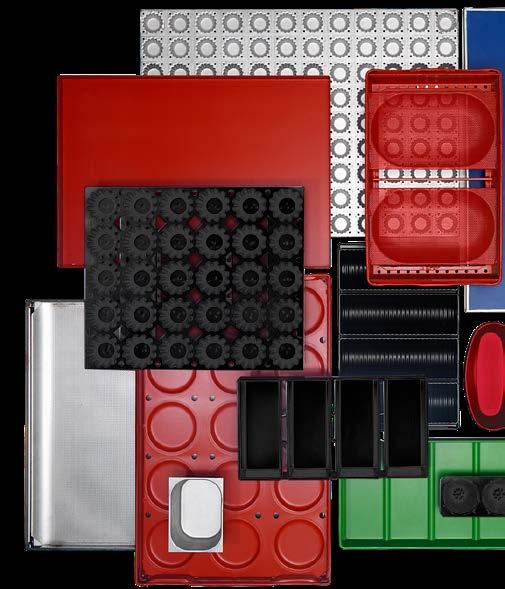
Lhotellier R2A, a subsidiary of the Kaak Group in the Netherlands, has developed and marketed non-stick coatings for the baking sector since 1963. Experts provide support when choosing optimum non-stick and de-panning coatings.
+L hotellier R2A is considered to be a specialist for tray and pan cluster cleaning and (re )coating, since this Kaak Group company has developed and marketed non-stick coa tings since 1963. In this respect, Lhotellier R2A offers a wide selection of different coatings to guarantee optimum de-pan ning with any product and every kind of pan. The company promises that greasing becomes wholly or partly superfluous, depending on the coating and product. These coatings are suitable for all types of materials, and satisfy the European Directives for products that come into contact with foodstuffs.
A multi-layer system
The coating for pan clusters or trays is applied by means of a multi-layer system. The surface texture is of the greatest importance to ensure a strong bond with the coating. There fore the first step in the coating process is thorough cleaning of the surface. After this first step, a primer coat is applied to maximize the bond between the pan and the non-stick coating. Depending on the specification, this is followed by the application of one or more coats with specific de-panning properties. Finally, the coating is sealed, creating a uniform, hard-wearing coating with corresponding proofing, baking and de-panning properties. As a rule, the outer surface of the pan is given a black enamel coating to ensure optimum heat transfer.
The company offers the following coatings: Multi-Flon ® : According to information from the company, a Multi-Flon ® fluoropolymer coating provides a high degree of resistance against abrasive wear, chemicals and rusting.
Multi-Sil R ® : According to Lhotellier R2A, the Multi-Sil R ® rubber-silicone coating is suitable for baguette baking trays and for applications involving sweet dough.
Multi-Sil G® : The Multi-Sil G® coating is said to be especially suitable for very viscous doughs or batters such as cake dough, but is also frequently used in the production of bread and confectionery.
The company constantly carries out research on new coatings, and as Bruno Servant, R&D Manager for Lhotellier R2A, explains: “Optimizing our coating is a continuous process. That’s logical, since our customers increasingly seek perfection.”
As well as consultancy and cleaning & (re-)coating trays and pan clusters, the company also offers the das iBakeware ® detector system. This system uses an ID (identification) code located on the product carriers, i.e. on trays or pans. The Kaak ID system scans this ID code and can thus recognize which product carriers need to be recoated or replaced
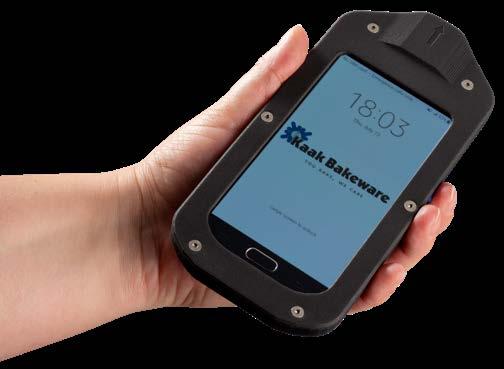
www.bakingbiscuit.com 04/2019 PANS AND TRAYS 32
+++
++ Lhotellier R2A constantly researches and develops novel coatings for a wide variety of applications in the baking sector
© Kaak
++ The iBakeware® detector system reads the ID (identification) code on trays or pans, thereby recognizing which product carriers need recoating or replacement
©Kaak
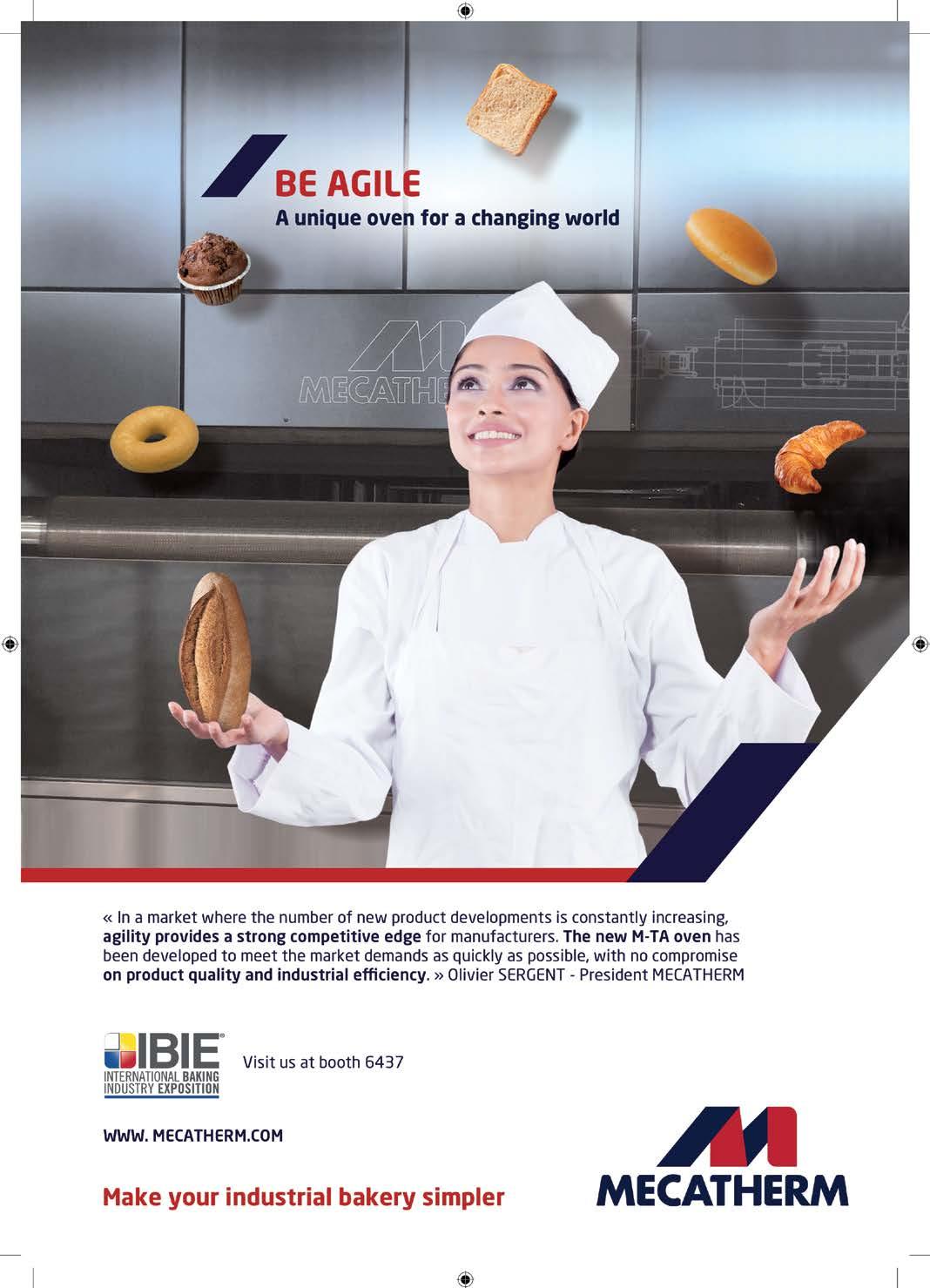

Absolutely flat and warp-free
The experts at acs Coating Systems GmbH, Wilhelmshaven/Germany, have developed new coatings and trays.
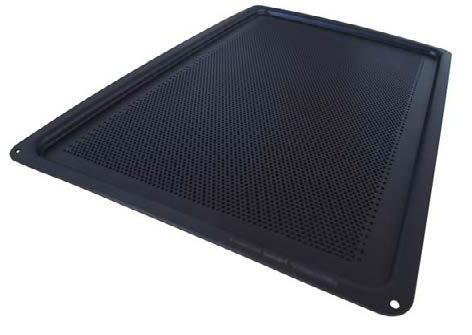
+The name says it all: Hifficiency® stands for High Efficiency. Explaining the new developments, Dr. Christoph Stecher, Managing Director of acs Coating Systems GmbH, Wilhelmshaven, says: “For baking that means: avoiding even baking paper, greatly reduced use of separating agent, or none at all, shorter baking times, easy cleaning, e.g. in a tray washer, and longer lifetimes for the coating and for the complete baking ancillaries.” Moreover, this is made possible by the latest DURAPEK ® nonstick, multislide ® coatings, which are robust, lye-resistant and tray-washer-proof, as well as showing only a fraction of the wear compared to conventional PTFE-/ PFA-/Teflon coatings, not to mention silicones. Dr. Stecher goes on to explain that “You have another benefit, especially for instore baking: they contain no solvents, or resins that are not particularly temperature-resistant. Even at high temperatures, there are no out-gassings of pollutants, i.e. no fluorine, no PFOA, no PFO, no benzene, no (bis-)phenols, no sulphones etc., and the coatings are suitable up to more than 300°C.” He says that is also unique. These coatings, for which multiple patents have been issued and which are manufactured on special plants at acs without the use of s olvents and paint chemistry, is the high-performance plastic polyaryletherketone. According to the expert, this is naturally much harder and more resistant than any fluoropolymer/Teflon or the plastic resins that are normally used. The Managing Director goes on to stress that “acs produces the lacquer powders itself, and these coatings are not available anywhere else.”
Non-stick effect
Since the non-stick effect functions very well in the great majority of applications, Hifficiency ® accessories can be used quite universally. However, Dr. Stecher points out that specially modified recipes are needed for some applications, e.g. bread pan clusters.

Furthermore, he also says acs has developed a new generation of baking trays that do not warp in the oven, and are also altogether much more robust than all the trays that are

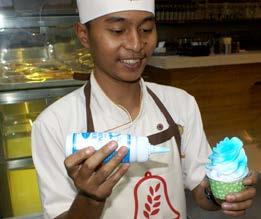
customary nowadays. The slightly higher procurement price should be depreciated quickly due to the longer lifetime and the benefits described above.

For first baking with a lye-dip, acs has developed the Hifficiency ® perforated lye tray on which patented technology is used to sheath the entire aluminum body with the coating. According to Managing Director Dr. Stecher: “The oldest such special perforated lye trays have now been used in customers’ operations for three years, where they have had no problems in passing various official tests and inspections – without baking paper.”
Nevertheless, there are customers who want to use absolutely no aluminum at all, so as to be entirely on the safe side even from the theoretical point of view. The company reported that acs has now developed a coated stainless steel tray for this purpose, and in this respect, the disadvantages of stainless steel in baking behavior compared to aluminum are compensated by a special thicker DURAPEK ® variant. The company has something new to offer even if the customer uses a traycleaning machine. +++
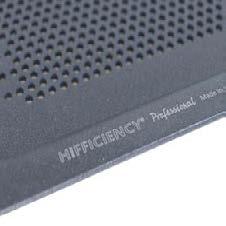
PANS AND TRAYS 34
++ The new Hifficiency® instore baking tray with DURAPEK® is said to be absolutely flat, warp-free and especially durable ADVERTISEMENT With color, please: the art of baking in Indonesia
©acs • Read the whole story on • backweltblog.com
The most unusual shapes are possible

From idea through design to the finished pan, this service is now offered to customers by Anneliese Backtechnik GmbH, Eschweiler/Germany.
++ 3-D draft designs for a bear mold
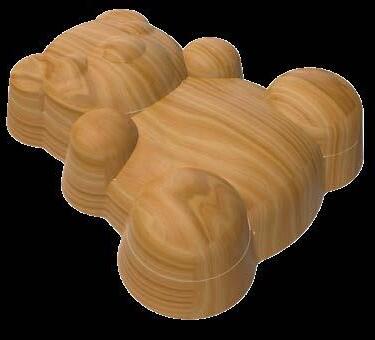
Unique selling points are a must nowadays. According to Anneliese Backtechnik GmbH, this is simple and easy if the article in the window display already stands out because of its unusual shape. This medium-sized company in Eschweiler offers its customers a full service in this area. As General Manager Angela Leuver explains, there are almost no limits to customers’ wishes in this respect – the customer’s requirements are accompanied and perfected in all areas from the idea to production-ready implementation. Thanks to in-house tool production, even the most unusual shapes can be fabricated by deep-drawing technology, so the baked product has no unwanted corners and edges. She goes on to say that of course these pans are manufactured with a coating to match the dough used by the customer. As well as the result of baking, this also gives the pans a long lifetime. The customer decides whether he/she will be supplied with individual molds, entire pan clusters or even whole plant pan assemblies.
This is how it works:
+ The customer presents his/her idea for a pan or design.
+ The company then prepares a 3-D design draft.
+ The 3-D design draft then undergoes further modification according to the customer’s wishes.

+ A negative is produced in a 3-D printer. This is used to create an initial silicone version of the baking mold, which the customer can use for trial baking runs and can test the result of baking. After that, further corrections required by the customer can take place if necessary.
+ After the customer has approved the mold, the final deep-drawing tool can be fabricated.

+ The coating is selected together with the customer and in accordance with the latter’s requirements.








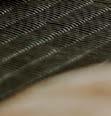


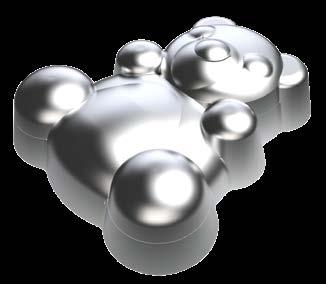
+ A customized pan is produced. +++
Analyse and optimize your baking process. Check

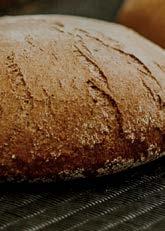

directly in your oven.

» Autonomous logging up to 90 min/ max. 280°C possible

© Anneliese
» With 3 humidity and 7 temperature sensors in one datalogger

» Customer adapted solutions (length and number of sensors)


» Easy to use
» Climate profile measurements are also o ered worldwide as a service
» Made in Switzerland
PANS AND TRAYS
+
PHTM humidity and temperature datalogger Experts on Design-In ZURICH - SWITZERLAND Pewatron AG info@pewatron.com Phone +41 44 877 35 00 a member of the Angst+Pfister Group Visit us at the IBIE at booth 2275
the uniformity
Compact, efficient, universally usable
He goes on to say that almost all types of baking tray can be cleaned dry and oiled with the BELT-OILER-R combination machine Trays are cleaned using novel belt brushes that fit into the tray’s contours, recesses and corrugations. The nonstick agent is applied through special sensorcontrolled air-mix nozzles for economical consumption. The BELT OILER-R can be used in many areas: smooth, flat trays with up to four rims, baguette trays with or without a frame, perforated or unperforated trays, coated or uncoated trays – with widths of 600, 800 mm or 1,000 mm. Hourly capacity is up to 1,200 trays. The plant is said to be simple and easy to operate, and servicing costs are minimal.
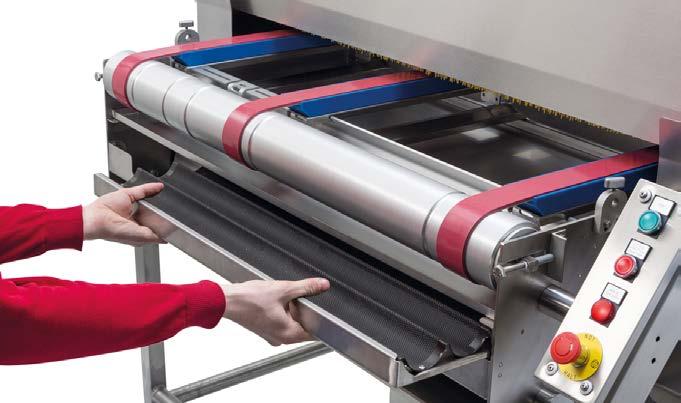
+P recisma GmbH in S ipbachzell/Austria, is a baking tray cleaning specialist. The company has now developed the BELT-OILER-R combination machine, with which baking trays can be cleaned and oiled in a single working step. After the cleaning and oiling process, a return conveyor then takes the tray back to its starting point. The machine can be operated by a single person, and due to its compact construction, it needs only a small footprint.
A new coating
The BELT series of baking tray cleaning plants, the OILER series of non-stick agent application plants and the POWDER series of strewing plants are fabricated on an individually customized basis. The company stated that this gives each customer everything from a single supplier: from the budgeting, planning, specification preparation and design to manufacture, commissioning and servicing of Precisma machines. +++
KG-Flon 603 green is the name of the latest fluoropolymer from Kempf. The coating has a multi-layer structure and is said to have a long working lifetime.
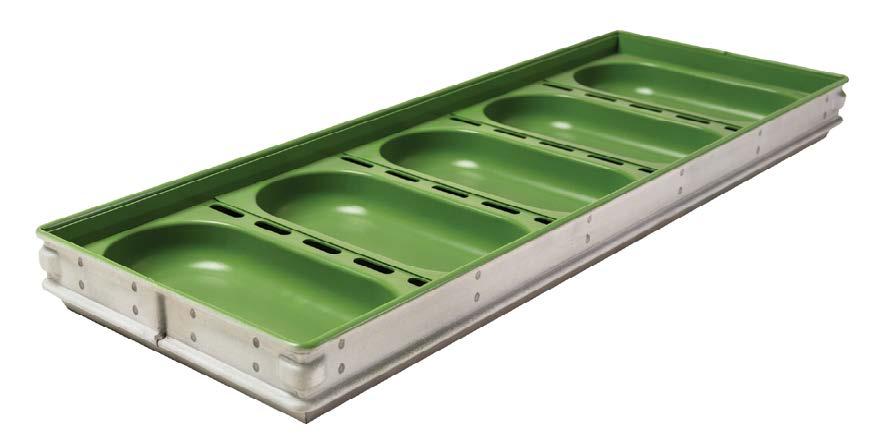
+Kempf GmbH, Rohrbach/Germany, is currently planning an expansion of the factory in Rohrbach. Managing Director Guido Kempf is altogether satisfied with the economic situation, and has plans for the company to continue to grow. In this respect, in addition to further automation in the production area, the company also focuses on new products such as the KG-Flon 603 fluoropolymer coating. Its charac teristic feature is said to be outstandingly good non-stick properties, chiefly with sweet baked products. It also has very good corrosion resistance and a long lifetime due to its multi-coat structure. As Managing Director Guido Kempf explains: “Baking paper can be completely eliminated in the bake-off area, since even sweet cake slices and puff
pastry baked products can be baked on
This
www.bakingbiscuit.com 04/2019 PANS AND TRAYS 36
++ A pan cluster with th e ne w KG-Flon 603 green fl uoropolymer coating
©Kempf
them.
elimination of baking paper leads to big savings and avoids a large volume of trash.” +++
++ The new “BELT-OILER-R” combination machine cleans and oils baking trays in a single process
© Precisma
Introducing Hydrobond from Exact Mixing




















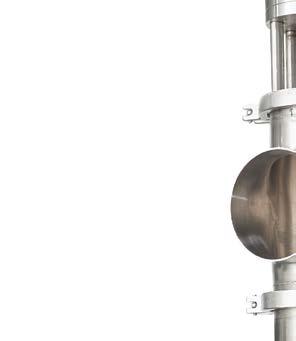



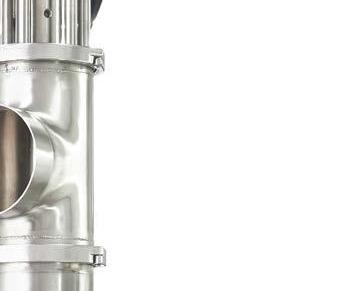

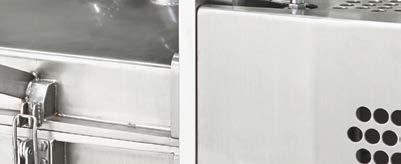
Want superior hydration without adding excess heat to your dough? New Hydrobond technology delivers. Not only does it blend dry and wet ingredients with unmatched efficiency, it also:
• Requires no additional floor space






• Reduces your total mixing time
• Cleans quickly and easily






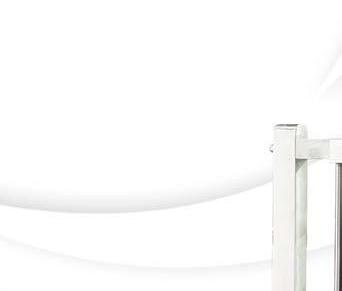
• Reduces heat attributed to mixing energy


• Allows you to mix more dough with same size continuous mixer

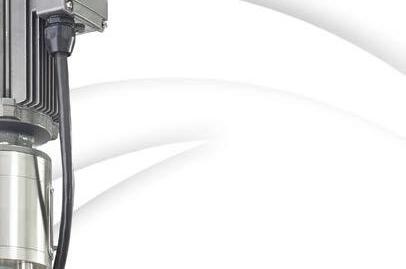




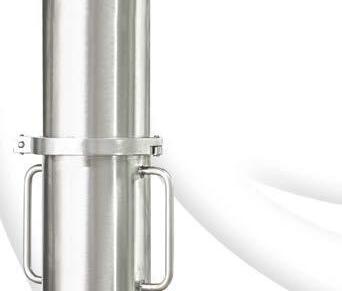
 BY READING BAKERY SYSTEMS
BY READING BAKERY SYSTEMS




Perfect your mixing process with new Hydrobond technology. Visit exactmixing.com for details. Advanced hydration technology is here.
A Markel Food Group Company EXACT MIXING
Visit us at Booth 5521
“It`s important to understand the African market”
The Dimassaba Group opened a new bakery in Luanda, Angola’s capital city. The factory, which is called Dimapão, uses a Mecatherm industrial bread line.

Hussein Bourji, President of Dimassaba, says “Our new production site is equipped with the country’s biggest bread production line. Our line is able to produce 180,000 breads per day. In a first step, we start production with 150,000 breads per day.” This is equivalent to more than 6,000 bread rolls an hour.
The wheat baked goods weighing 95 g made at the Dimapão site with its 30 employees and a production area of around
400 m 2 represent Angola’s most usual type of bread. The industrial process guarantees that the finished products have a consistent weight and a high level of hygienic safety.
Hussein Bourji: “For equipment, we work only with Mecatherm. The automatic production line consists of a MVS proofer, an ‘S’ oven and an MVS cooler. Mecatherm was the best choice for the equipment, but also for their support to set up the project.” Together with Dimassaba, this was the
Dimassaba
Dimassaba – Le Comptoir d’Export (Export Desk) is a familyrun group under the direction of Hussein Bourji and Karim Bourji. The company was founded in 1993 and employs 400 staff from Angola (for all the group’s activities) and 40 expatriates. Dimassaba produces breads at the Dimapão site, but raw materials importation is the group’s historical activity. Hussein Bourji: “We import our flour from French mills. We also are
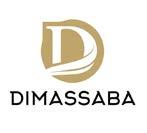
+++
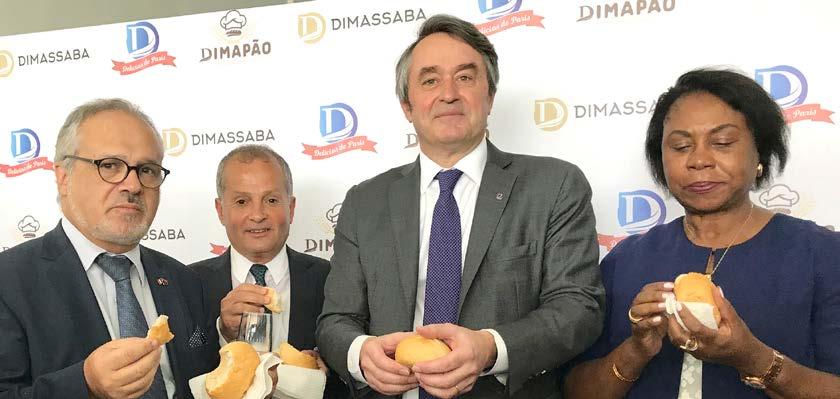
www.bakingbiscuit.com 04/2019 PRODUCTION 38
+
© MECATHERM
++ At the inauguration: (l. to r.) Sylvain Itté, French ambassador to Angola, Hussein Bourji, President of Dimassaba, Olivier Sergent, CEO of Mecatherm, and Bernarda Martins, Angola’s Minister of Industry. They are holding the 95 g wheat baked goods produced in the new factory
++ Together with Sylvain Itté, Bernarda Martins cuts the ribbon for the official start of the Dimapão factory
© MECATHERM
in discussion with the Angolan authorities to open a mill in the country, whose capacity would be to produce five thousand tons of wheat flour every month.”
++ In a first step, Dimassaba starts production with 150,000 breads per day
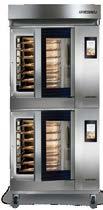
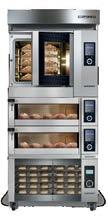
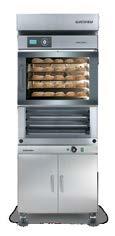
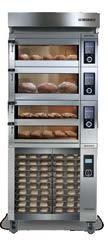



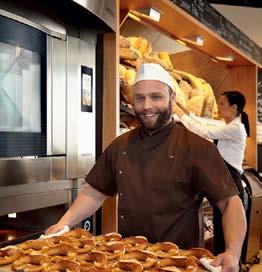
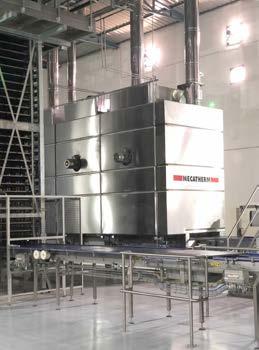
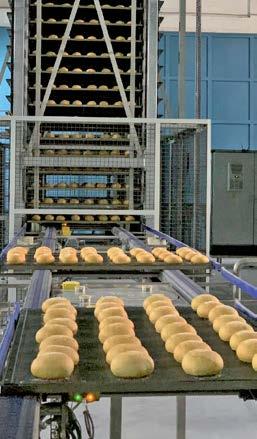
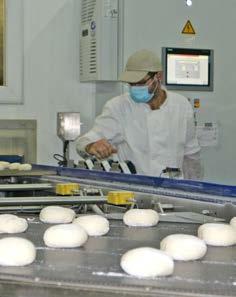
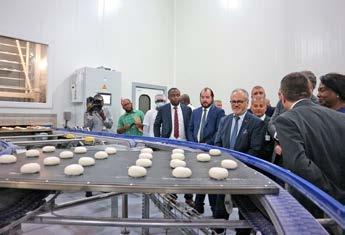
Angola
Angola, the República de Angola (Portuguese), or the Repubilika ya Ngola (Kimbundu, Umbundu and Kikongo), with its capital Luanda, is situated in Southwest Africa. The official national language is Portuguese, which is spoken by about 30% of the Angolan population. In addition, the most widespread African languages are Umbundu, Kimbundu and Kikongo. According to the World Bank, around 29.78 million Angolans live on an area of around 1.25 million km 2, approx. 7 million of them in Luanda. The gross domestic product is USD 121.1 billion, equivalent to USD 3,570 per capita (2017, World Bank). According to the Human Development Index of the United Nations Development Program (UNDP), Angola ranks 147th out of 189 countries (Website: http://
ADVERTISEMENT
hdr.undp.org/en/countries/profiles/AGO).
Sources: Wikipedia, Foreign Office of the Federal Republic of Germany, Human Development Reports +++


39 PRODUCTION www.bakingbiscuit.com 04/2019
©
©
© MECATHERM
++ In the production unit in Luanda. Altogether, the line consists of an MVS proofer, an ‘S’ oven and an MVS cooler © MECATHERM © MECATHERM
Free Vector Maps.com
MECATHERM
www.wiesheu.de/en Area Sales Manager UK & Ireland Simon Lilley Tel. 07818 568889 simon.lilley@wiesheu.de In-store
ANGOLA LUANDA Perfecting the art of in-store baking to suit your needs is our motivation. It has been for over 40 years.
AFRICA
baking means gai ning customers.
The bread market in Angola – a short interview with Hussein Bourji
+ bbi: Mr. Bourji, how important is bread in the nutrition of the Angolan people?
+ Bourji: The people eat bread every day. It’s a staple foodstuff.
+ bbi: How would you describe the bakery market in Angola?
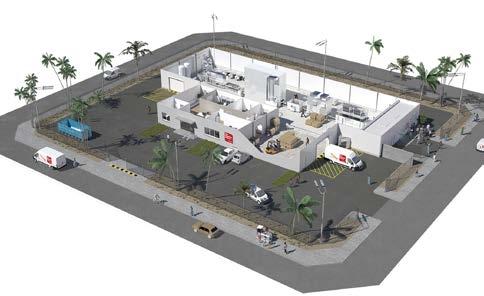
+ Bourji: Demand in Angola is strong, in a very competitive market.
+ bbi: Who are your competitors in Angola?
first time the plant constructor had implemented its turnkey concept of “The Baguette Factory”, which is specifically matched to the African market. (See also the article entitled “The Baguette Factory” on this Page.) Mecatherm not only supplied the production line but also actively assisted Dimassaba in the project design phase, including planning the buildings and financing, and trained employees to control and service the line.
The bread rolls are distributed all around Luanda. As Bourji explains: “Our products are sold in local bakeries, in the markets and by street sellers in the street. Street sale is the
+ Bourji: In Angola, many small bakeries and semi-industrial bakeries (small sizes) produce bread. In terms of quality, we do not have any competitors; we are the best. The quality of our products is renowned in the market.
+ bbi: Is further expansion planned?

+ Bourji: We plan to develop a second production line at Luanda.
+ bbi: What ideas do you have for the future?
+ Bourji: In a second step, we would like to develop our production in the provinces. +++
most important bread distribution channel in Africa. They are organized by networks, so we work with the sellers’ networks. Obviously we also work with supermarkets and retail outlets.”
Dimassaba invested around USD 5 million to launch the production facility. The price of bread in Angola is regulated by the state. Hussein Bourji: “It’s important to understand the African market context, which is really specific. In a large part of Africa, including Angola, bread is a basic necessity product like rice. That’s why the authorities regulate its price.” +++
The Baguette Factory
+M ECATHERM handles projects around the world –particularly in Africa, where many of the population (in western, central, southern and some eastern areas of Africa) consume crusty bread such as baguettes. The market is mainly dominated by traditional production methods. With “The Baguette Factory”, MECATHERM developed a simple, profitable turnkey solution for companies planning to enter industrial bakery production. CEO Olivier Sergent: “The Baguette Factory embodies our vision for the industry and our expertise in the African market.”
The turnkey solution consists of:
+ 100% automated production line with various features (boiler, compressed air production, water cooler, etc.), allowing a small 3-person team to achieve a production rate upwards of 4,000 fresh baked baguettes per hour
+ Project management with a dedicated team (study phase, implementation, after-care, etc.)
+ Installation and start-up of the production line managed by MECATHERM technicians
+ Training and assistance provided by the company’s bakery technicians
Additional services are also available, ranging from support during the feasibility study phase and help with recruiting
factory managers capable of handling these types of projects, through to assistance in sourcing finance, plus a multitude of after-sales services.
Jean-Yves Bruckert, Sales Director for Africa: “Experience has proved that simply supplying a ready-to-use production line is not always enough to guarantee a project’s success. This is why, through working closely with specialist partners and local representatives, we have developed a turnkey solution to support our clients during every stage of their projects.”
In February 2019, MECATHERM completed the first project of its turnkey solution – for DIMASSABA. +++
www.bakingbiscuit.com 04/2019 PRODUCTION 40
©MECATHERM
++ Th e Baguette Factory is a turnkey solution aimed at the African market
© MECATHERM
dough preparation
dough dividing
dough moulding
proofing
frying
baking
pasteurizing
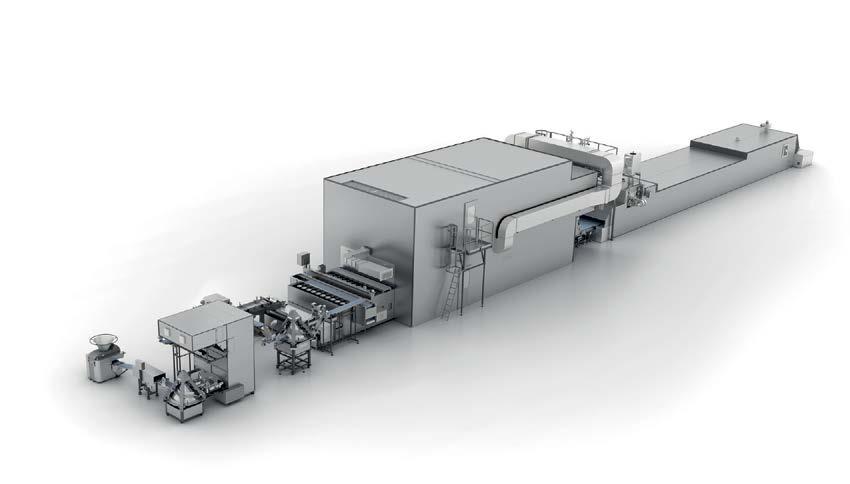
cooling
deep-freezing
product handling
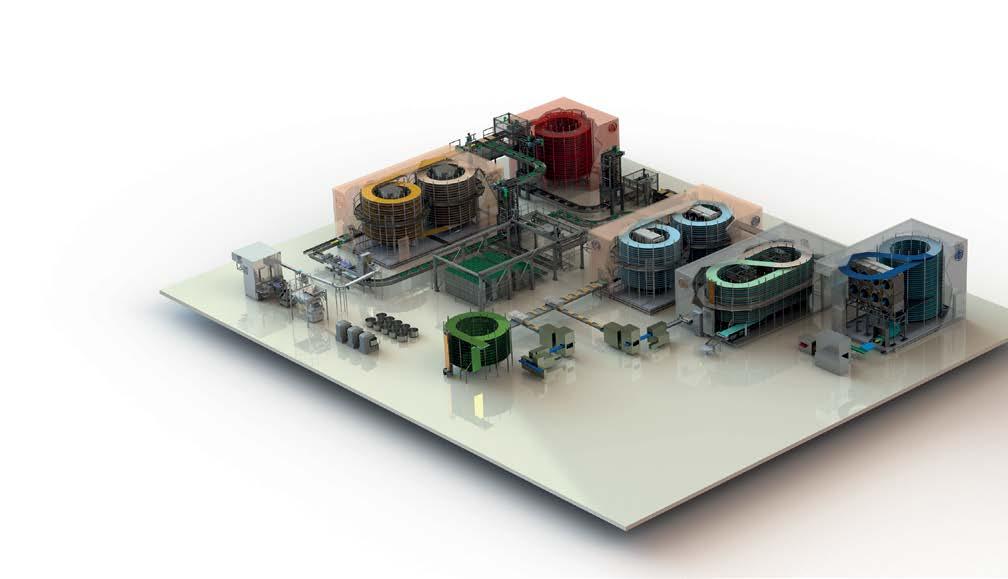
One for all doughs
The new König dough sheet former can be used to make a very wide range of baked products. There is now almost no upper limit to the variety of products that can be made from a dough sheet.
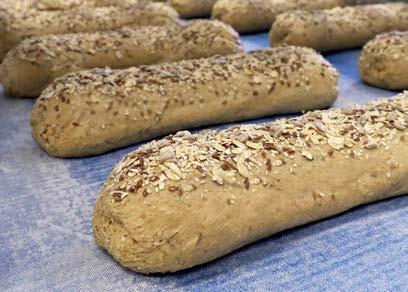
Kornecke or ciabatta – this dough sheet former from König Maschinen GmbH, Graz, Austria, can be used to process a wide variety of doughs to make many different baked products from a dough sheet. Moreover, whether the weight is large or small, rolled out thin or round-molded, dough sheet plants are a good opportunity for bakeries to
manufacture many different products on a single line. To allow Menes lines to work with a very wide diversity of doughs, König has also developed a universal dough sheet former that can process both soft and firm doughs. It features a 3-roll dough sheet former to ensure a continuous dough sheet.
Plug-in rollers
The heart of the dough sheet former are plug-in rollers with different surface textures which the company says can process both firm and soft doughs. This makes the dough sheet former equally suitable for coarse-pored ciabatta doughs with a dough hydration of 185 and for fine-pored lye roll doughs with a hydration of 150. This component allows the manufacture of a product assortment ranging from breads, baguettes, bread rolls, toast-bread, pizza, donuts and cakes to flatbreads and tortillas.
Between the specially-designed rollers, the dough sheet former creates a uniform, continuous dough sheet whose sheet thickness can be adjusted continuously. The rollers are specially arranged so the shaped dough sheet adheres to the rollers and is supported by rolls to prevent it flowing uncontrollably
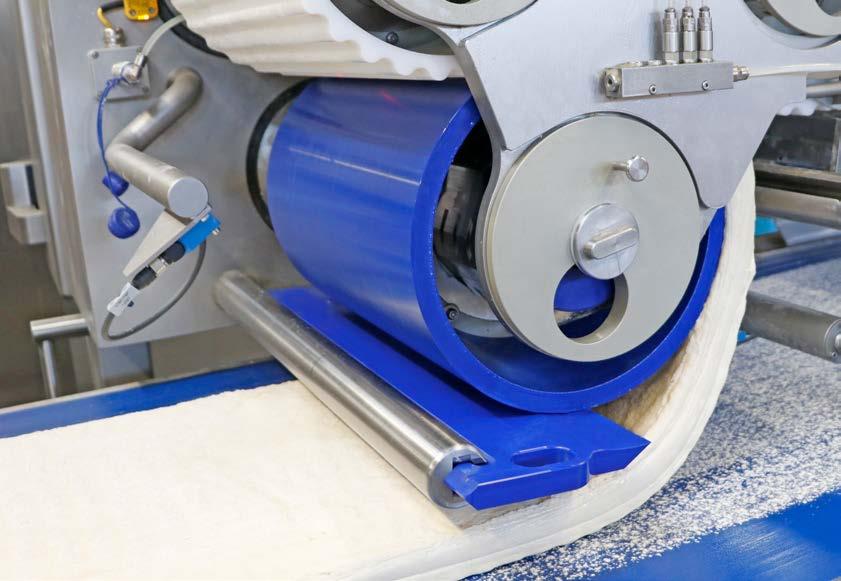
www.bakingbiscuit.com 04/2019 PRODUCTION 42
++ The König dough sheet former processes soft and firm doughs
++ A wide product range can be made from a dough sheet
© König
© König
+
under its own weight. The pneumatic scraper separates the dough sheet from the rotating roller and deposits it onto a conveyor belt for further processing in the plant. As a result, the dough sheet is shaped very gently and without any stresses. The dough sheet former can process up to 5,000 kg/hour of dough, depending on its configuration.
Quick-change system
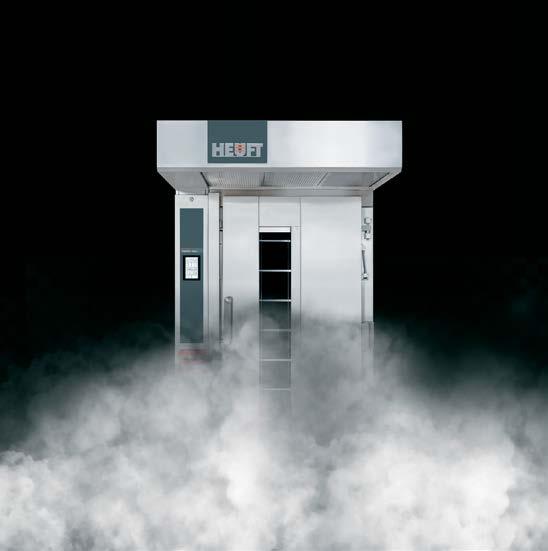
The quick-change system in various widths allows the use of different rollers to set dough sheet widths from 250 to 600 mm. This precise setting depending on the product and its weight also allows scrap dough to be minimized.
The self-supporting side-plates and rollers are cantilevered and are thus easy to remove and change without tools, which enables minimum retooling times when there is a product change on the line.
The entire Menes-H has a Type “H” hygienic design. All the mechanical drive components are encapsulated to isolate them from the dough area, and the use of sealed bearings makes the plant, including the dough sheet former, “washdown-safe”. The entire dough sheet former can be pulled out on its own frame for cleaning and maintenance. In addition, the rollers and side-shields are easy to remove and can be washed separately. +++
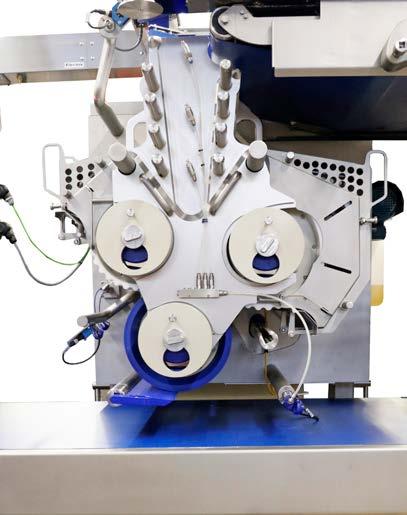
43 PRODUCTION www.bakingbiscuit.com 04/2019
ADVERTISEMENT
++ Fo r easy cleaning, the dough sheet former is mounted on pull-out frames
© König
Endless steam. IBIE
Las
– www.heuft-backofenbau.de
2019
Vegas, USA, booth 7737
The Number 1
Cookies, waffles, crackers and baked products from PT. JADI ABADI CORAK BISCUIT FACTORY INDONESIA are very popular in Indonesia. The company, a subsidiary of the Khong Guan Group, is regarded as the

+According to its own statement, PT. JADI ABADI CORAK BISCUIT FACTORY INDONESIA is the market leader in Indonesia in the waffles and cookies segment, with a market share above 50%. In all, the company operates six production facilities with around 50 production lines employing approx. 3,000 staff. Its products are popular not only
among Indonesian consumers. The company exports around 10% of its baked goods to countries such as Singapore, Vietnam, Myanmar, Hongkong, Taiwan, East Timor and the USA, and even supplies parts of Africa. Explaining the corporate goals, Factory Manager Budi Kurniawan T. says “Our vision is to be market leader for cookie production in this country and abroad. We will achieve this by manufacturing high-quality, innovative products at a competitive price.” The industry expert is responsible for the Surabaya site with around 800 employees.
As well as producing crackers, hard wafers and various types of cookies, the company also manufactures puff pastry products in various flavors. Consumers can buy the products in the food retail and from small traders in all of Indonesia’s regions. In this respect the company has established a wide variety of brands, e.g. Monde, Kogen, Motta, Khong Guan or Top. Budi Kurniawan T. explains that “This brand strategy allows us to reach various groups of buyers and to offer to a wide variety of segments – from cheap to premium.” He also
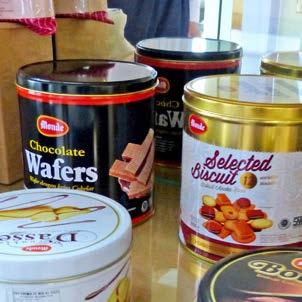
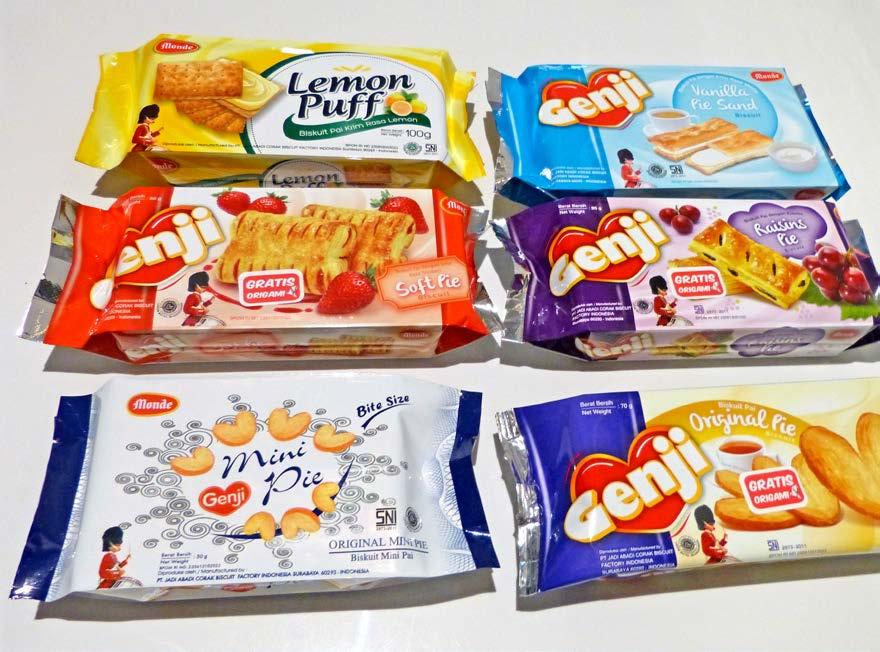
www.bakingbiscuit.com 04/2019 PRODUCTION 44
© f2m ©
Sajapong Rhienmora –123rf.com
MALAYSIA
PHILIPPINES AUSTRALIA INDONESIA
Consumption habits
ASEAN consumers are buying increasing amounts of processed foods, and according to the Euromonitor for packaged food and drink, around USD 108 billion were spent in 2015. A forecast goes on to say that purchases are predicted to rise to USD 164 billion by 2020. The growing middle classes in towns are especially receptive to this, and are also said to have the necessary purchasing power. Although they are still small groups in Myanmar, Laos and Cambodia, urbanization is progressing rapidly in Indonesia, the Philippines and Thailand, and is changing consumption habits. Euromonitor also says Singapore depends almost entirely on imported food. Consumption habits here are the same as in other world cities, with an Asian flavor. An example of a trend shared by these countries is the increasing replacement of rice by baked products as the staple foodstuff.
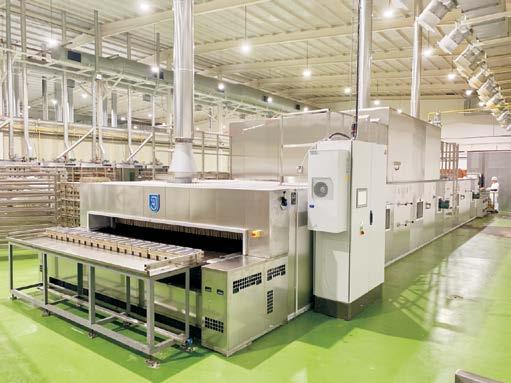
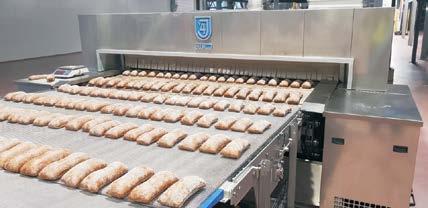
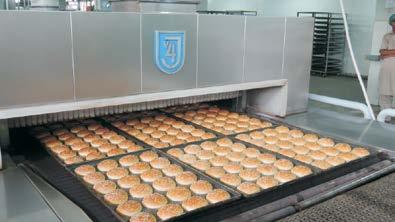
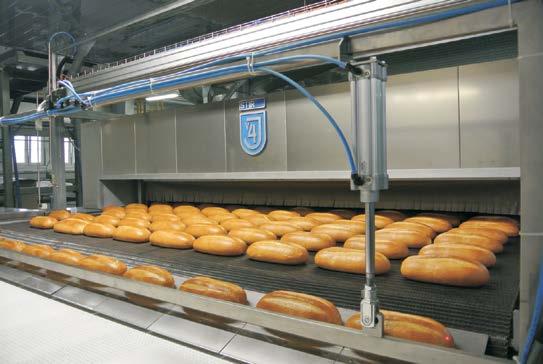
For the whole region, Euromonitor estimates sales revenues in restaurants in 2015 at more than USD 100 billion. It goes on to say that restaurant visits, and fast food in particular, still have big growth potential, and these areas are booming, especially in Vietnam and the Philippines. +++
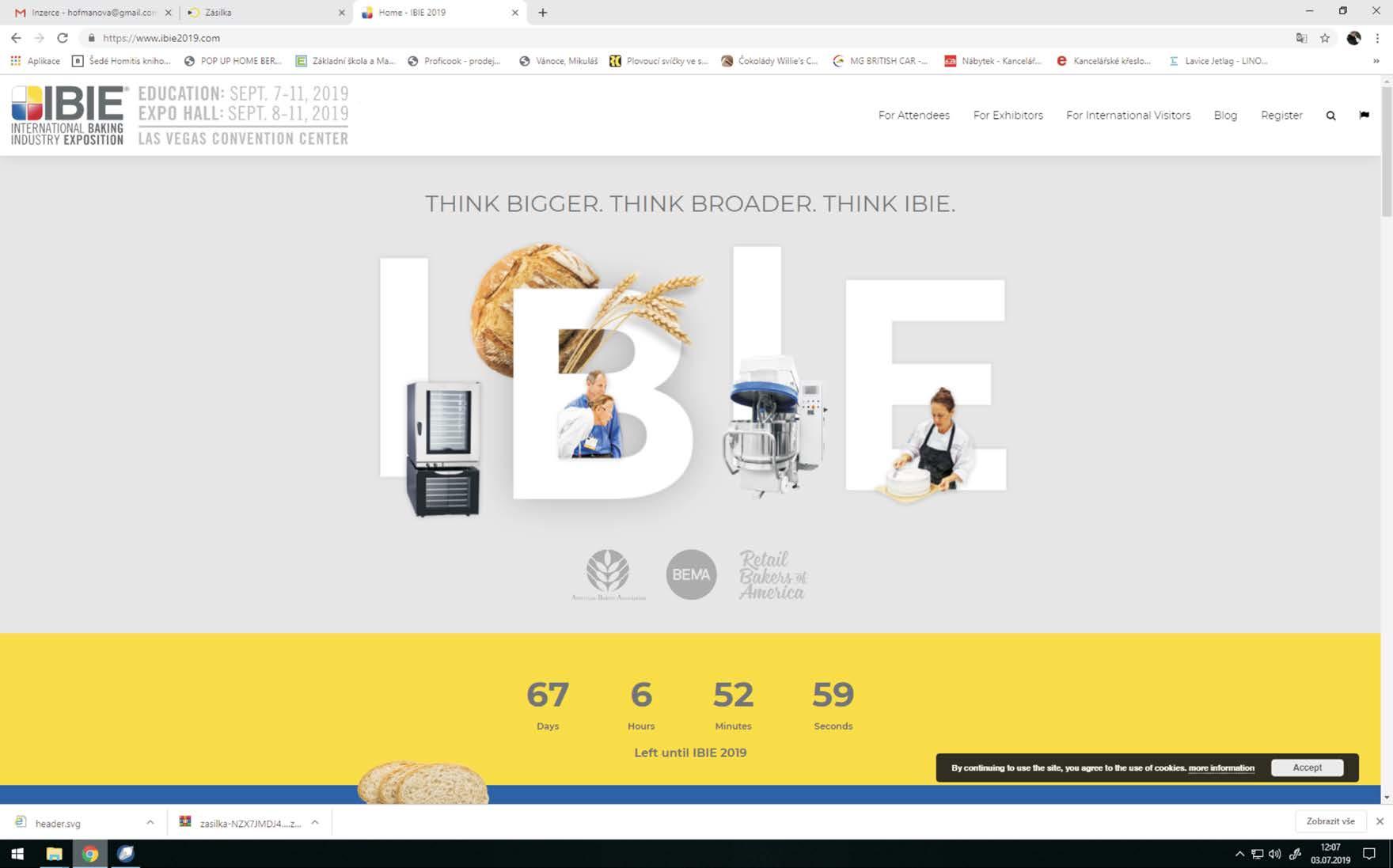

PRODUCTION ADVERTISEMENT
© f2m
++ Th e Surabaya location is one of a total of six production facilities in Indonesia, and the fourth-largest in the Group. The production buildings are visible in the background
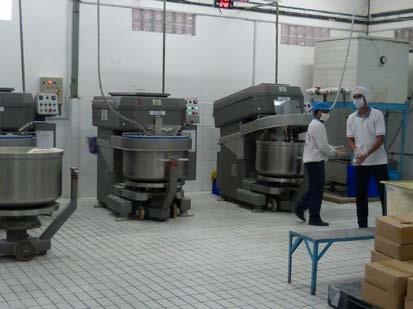
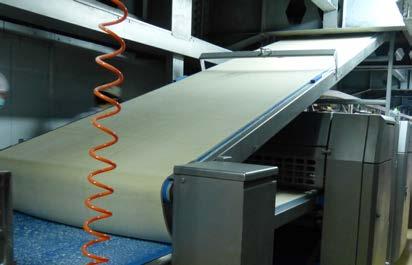
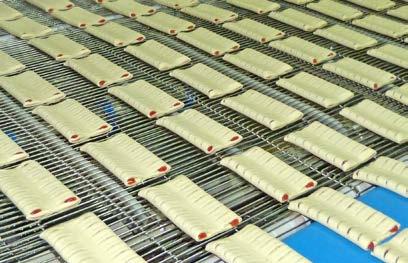
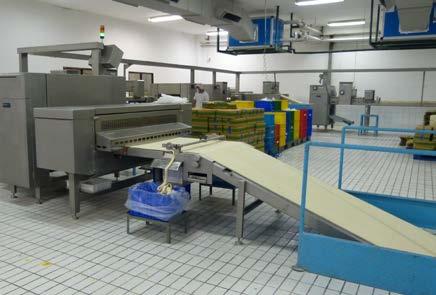
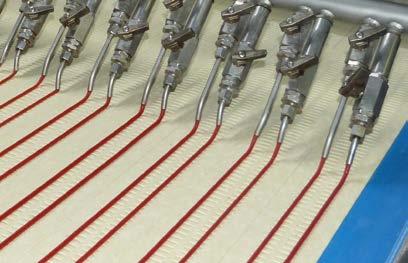
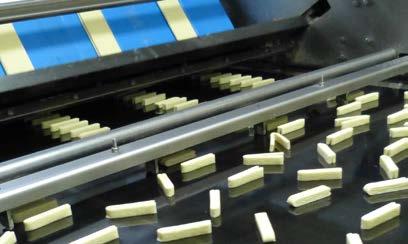
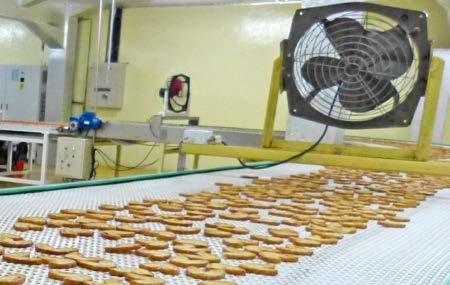
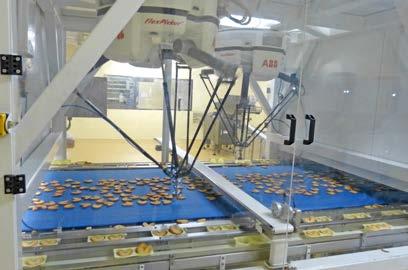
www.bakingbiscuit.com 04/2019 PRODUCTION 46
++ Do ugh preparation and parts of the laminating lines are one floor above the make-up area
++ minated dough arrives on the ground floor for further processing
++ In to the single-deck tunnel oven after filling and folding
++ Th e company makes its own fruit fillings
++ An other line, another product: these are mini-palmiers being separated before baking
ff pastry products are cooled, then packed by robots
©
f2m
© f2m
© f2m © f2m
© f2m © f2m
Southeast Asian economic zone
Southeast Asian countries are among the world’s biggest rice producers, but according to a GTAI (Germany Trade & Invest) press release early in 2019, growing urban populations are increasingly asking for imported foodstuffs. Baked products in particular are taking over from rice as the staple food. Figures for the Southeast Asian market are available especially from the ASEAN (Association of Southeast Asian Nations), an international organization of Southeast Asian countries based in Jakarta (Indonesia). The Heads of State and Government of the ASEAN members decided in September 2009 to create a common economic area modelled on the EU. Today, ASEAN comprises ten member states with a combined population of over 600 million. Its gross regional product (GRP) is growing at an average rate of about 5.3% p.a. Indonesia, which makes up about 40% of the population and has a GRP share of approx. 70% of the total, is a heavyweight in the ASEAN.
Indonesia has the region’s largest agricultural land areas, and the country is the region’s biggest food exporter. However, these exports consist mainly of palm oil. Food exports also play a very important role for Thailand and
Vietnam. However, rice is the main export alongside fruit and fish products.
The GTIA report also says that Indonesia, with the biggest market, also has the largest food-processing sector with around 1.6 businesses. These companies produce mainly for the domestic market. The Philippines and Vietnam also have large populations and significant food production. However, as the report goes on to say, these firms lack the money for investments, which is why value creation remains low.

Nevertheless, a few of the Southeast Asian food processing companies are among the world’s biggest. Examples include the beverage producer San Miguel in the Philippines, and the meat and fish processor Charoen Pokphand Foods in Thailand. Wilmar International, listed on the Singapore stock exchange, is considered to be one of the leading palm oil processors, and also operates in the cereals area. Indonesia also has important baked goods producers, e.g. PT. JADI ABADI CORAK BISCUIT FACTORY INDONESIA (see article “The Number 1”), or Sari Roti (see Box: “Indonesia’s bakery market”). +++
The new star in the baking universe
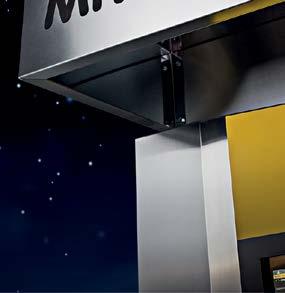



47 PRODUCTION ADVERTISEMENT
MIWE orbit An all-new rack oven designed and built by MIWE Germany ▶ Large baking area on a small footprint ▶ High-volume steam for an outstanding shine ▶ Perfect airflow for an even bake ▶ Easy to operate with modern touch-control panel ▶ Quick installation and easy maintenance ▶ Optimal energy use See it on www.miwe-orbit.com Touch it at the IBIE 2019 in Las Vegas Test it in the MIWE live baking center
The Indonesian bakery market
Indonesia is the world’s largest island state, with a population of about 255 million spread across 17,508 islands. This makes it the world’s fourth most populous country. Indonesia is also the nation with the largest number of Muslims worldwide.
The Indonesian Benelux Chamber of Commerce (INA/www. ina.or.id) studied the Indonesian bakery market in 2016, and found that there are around 640 medium and large registered bakery and confectionery companies (Source: Statistics Indonesia). However, there is an enormous number of small market participants, obviously unregistered, and the sector is growing enormously. According to the Indonesian Bakery Producer Association (APEBI), the average annual growth rate in the bakery sector is above 10%. Prospects are positive. According to Euromonitor, it may be possible to sell up to 688,000 tons of bread, cakes and pastries in 2019 due to sustained growth, and demand is rising. For example, it also says that consumption of bread,
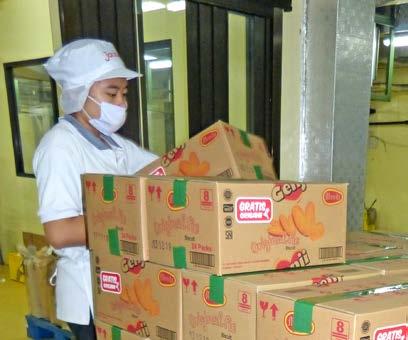
says it is important that the baked goods are produced according to Halāl standards and are accordingly certified to conform to Islamic dietary rules.
Production
Budi Kurniawan T. explains “We consider Europe to be a market leader in relation to the subject of cookies. That’s also why we like to buy lines from European suppliers. However, we also have machines from China or Japan in the production facility.” For specific solutions however, e.g. to fold minipalmiers, those responsible for the bakery like to fall back on Rademaker’s specialist know-how. For example, a total of three lines from the Netherlands supplier with a working width of 1,000 mm are located at the Surabaya site, where laminated dough is produced. Each line produces up to six different products. A few of the lines bake using tunnel ovens manufactured by Meincke (part of the Bühler Group). Budi Kurniawan T. is very pleased with the European plants, and keeps up a lively exchange with the mechanical engineer Rademaker in the Netherlands to gain information about the European market and new products. Where the supply of spare parts from the Netherlands is concerned, the bakery has had only good experience up to now, even when there’s a challenge.
The demand for cookies and other products is constantly rising – which is why the company is planning to build a new production facility soon, around an hour’s drive from the Surabaya site. It will then manufacture mainly new baked product creations with chocolate. Automation – from silo to packaging – is a major topic in relation to new buildings as well, because wages costs are rising in Indonesia, and consumers also demand consistent quality baked goods, especially from Indonesia’s Number 1. +++
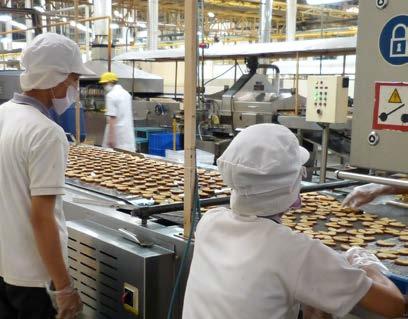
cakes and pastries rose by almost 60% from 2012 to 2016. The reason for the growth is said to be the ready availability of baked products compared to traditional rice or pasta dishes. In this respect, Indonesian consumers prefer baked goods with a soft, sweet texture. A visit to a café is another trend. As well as baked products, the rising middle class would also like to see tea, coffee and other beverages on the menu.
The big players in Indonesia include Sari Roti (PT Nippon Indosari Corpindo), Yamasaki, Shereen Bakery and Swanish Bakery. There are also chains with brands such as Holland Bakery, Delicious, Bread Talk, Kartika Sari, Tous Les Jours and PAUL Bakery. In addition, there are small and medium-sized bakeries operating only in the region, e.g. the Tan Ek Tjoan and Lauw bakeries. According to other figures, the baking industry uses up to 70% imported ingredients such as flour from Australia. Around 30% of the raw materials originate from Indonesia (Source: GAIN Report). +++
www.bakingbiscuit.com 04/2019 PRODUCTION 48
++ Mi ni-pastries leave the oven and undergo quality control
© f2m © f2m
++ Ca rtons are stacked on pallets by hand




www.wpbakerygroup.com Years 21.-24. September · Hall 9
Intelligent packaging
We talk to Martin Sauter, Sales Manager for Gerhard Schubert GmbH, about pick-and-place robotics and what the baking sector can glean from the confectionery industry.
bbi: : What is the market importance of using pick-andplace robots for packing in the baked products sector?

+ Sauter: The confectionery industry is the pioneer here but we still see a need to catch up in the baked goods industry, although we do notice strongly growing interest. We can often adapt solutions tried and tested in the confectionery industry for use in the baked products industry.
+ bbi: Where is the advantage compared to classical packaging lines?
+ Sauter: The flexibility and intelligence in packaging solutions using robotic technology lie in programming and robot tools. Avoiding mechanical components as far as possible in product and packaging handling opens up entirely new opportunities for gentle product handling and flexible packaging formats. A combination with image processing systems in particular, also developed and built by Schubert and which can be programmed using the VMS controller program, allows new standards to be reached in terms of production reliability, safety and quality. Short changeover times, flexibility for future requirements and performance redundancies can also be taken into account, as can cost efficiency and economy.
+ bbi: For which packaging and for which baked products are pick-and-place robots used?
+ Sauter: Basically, there is no product in the baked goods sector that we have not handled and packed at some time or other. Our machines take products from a product conveyor belt downstream of the industrial oven and place them into cardboard or plastic trays, and/or directly into the feeder chain of a horizontal tubular bag packaging plant. In the past few years we have supplied a very large number of plants for classical baked goods such as croissants, berliners, donuts, waffles/wafers, bread and bread rolls, and in addition to individual or small packs, these are often (on the same plant) put into large packages such as shipping cartons or plastic crates.
+ bbi: Which other tasks do you see in the future?
+ Sauter: We can very well imagine other (processing) operations being integrated into our plants. For the Italian baked products manufacturer San Giorgio, for example, we developed a plant to fill croissants with crème or jam before they are packed. In addition, by using the Transmodul, a transport robot, we can also implement chaining to upstream and/or downstream processes without any interfaces.
+ bbi: Where are the limits of pick-and-place?
+ Sauter: Strictly speaking, every automated packaging competes with manual work. Automation is often not very relevant for manufacturers in countries and regions with very low wage costs and where hygiene or quality aspects play a rather subordinate role. Conversely, this often means it is appropriate and worthwhile where just one of the above-mentioned factors applies.
+ bbi: Is factory size decisive for profitability?
+ Sauter: A few of our partners with whom we are in dialogue think that way. However, the opposite is shown by our experience and our list of references, which ranges from a small business with 30 employees to multinational groups.
+ bbi: At the outset you talked about the confectionery industry as a pioneer. In your opinion, are there any other aspects from which the baking sector could learn?
+ Sauter: Yes, ideas relating to goods presentation at the POS, pack formats, innovative packaging materials and forms of delivery. Here again, however, we can recognize the first of the forerunners who are developing away from packaging purely as product protection and are moving in the direction of lifestyle, differentiation and convenience. Too little attention is still paid in the baking sector to innovative technologies like packing in tubular bags, and to environmental aspects, e.g. moving away from a plastic tray and towards cardboard.
www.bakingbiscuit.com 04/2019 ROBOTICS 50
+
© Schubert
++ 4-Axis robots pick up cookies/biscuits from a conveyor belt and put them into trays
Video: Robotics at San Giorgio
You can view a video showing croissant filling and packing at the Italian baked goods producer San Giorgio at Youtube.

how a market can develop from a manual production site within a short time – due to favorable personnel costs and a good standard of education. Even just a few years ago, laborintensive production lines were still being relocated there on a large scale. In the meantime, these have now either been fully automated and moved back to where they came from, or the factories in Poland itself have been automated. The example of Poland is now applicable to regions of the world in Eastern and Southeastern Europe, Central and South America and a few regions in the Middle East and Asia.
+ bbi: Which baked products are difficult to handle?

+ Sauter: Products that are uniform and robust are the easiest to handle. However, our expertise lies precisely in handling sensitive, irregular products. By using a combination of image processing and tool development (grippers/suckers), we are able to develop a solution to match difficult product properties and pack requirements.
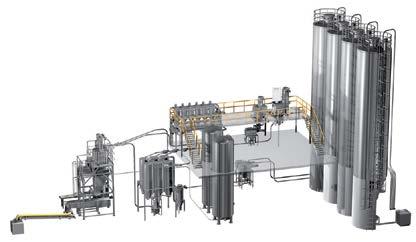
+ bbi: In which of the world’s regions do you currently observe the biggest boost in demand for pick-and-place robot technology?
+ Sauter: Due to the factors already mentioned, developed markets in Europe, North America and Japan are under the greatest pressure to act. But the example of Poland shows
PLANT DESIGN
+ bbi: Where are the challenges, e.g. when packing fat-fried products?
+ Sauter: Frozen deep-fried pastries can cause problems if they exceed the standard size. The grippers could be “crashed”. The quality and integration of image processing in conjunction with pick-and-place robots is decisive in this respect. Our image processing systems recognize oversize products – or
Plant engineering redesigned: We offer you the choice rather than ready-made kits – because we integrate processes, not just parts – for more efficiency, flexibility and security. Innovative plant designs from the plant architects. For a perfect dough all along the line.
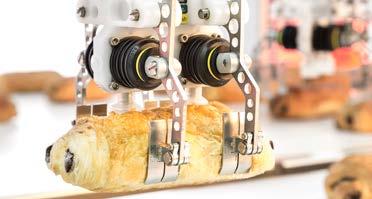
51 ROBOTICS www.bakingbiscuit.com 04/2019
ADVERTISEMENT
++ Fragile products like pain au chocolat can be handled using a gripper
zeppelin-systems.com
© Schubert
Visit us at booth 5829, Central Hall 031401904 _AD_Baking_Biscuit_Issue-2_Ausgabe-1_RZ.indd 1 21.05.19 10:33
RUNNING IN OUR VEINS –YOUR FUTURE ON OUR MINDS
Pick and place at ARYZTA
The picker line at ARYZTA’s site in Eisleben, Germany, takes donuts (berliners) from a conveyor belt and placed them into trays. According to ARYZTA, the plant moves around 40,000 donuts/hour.
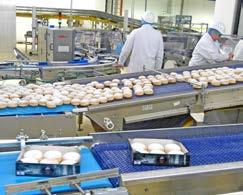
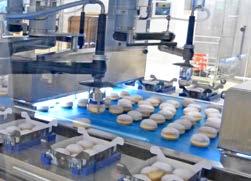
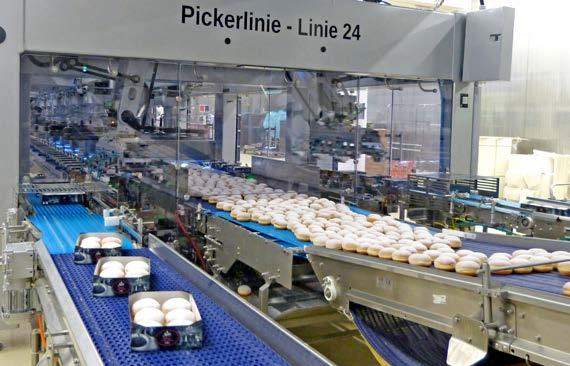
put a better way: they recognize products not only two-dimensionally (length and width) but also three-dimensionally (height and height profile). This enables us to almost completely exclude the product damaging the suckers or grippers.
+ bbi: … and when packing biscuits/cookies?
+ Sauter: Using a vacuum sucker to handle cookies/biscuits that have not fully cooled down is inadvisable, because fat that has not yet hardened can be sucked out, which can thus affect product quality and cause other plant malfunctions.
+ bbi: In which weight range do the baked products that are to be packed lie?
+ Sauter: There is no restriction with regard to weight.
+ bbi: What hourly performance capacity do pick-and-place plants achieve?
+ Sauter: As a rule we talk about cycles per minute, since a uniform product input rate plays a decisive role for optimum plant capacity utilization. We have probably already processed the complete performance range from very small rates of 30 pieces/minute (= 1,800 pieces/hour) to 5,000 pieces/minute (= 300,000 pieces/hour).
+ bbi: What limits maximum performance/capacity?
+ Sauter: Because we assembly robot systems modularly and can scale them, the entire plant’s maximum capacity is the sum of the capacities of the robotic assemblies required for it. Influencing factors that need to be taken into account include feeder belt width, maximum possible accelerations with respect to the product and tool (which also includes its weight), minimum and maximum travel distances, maximum speed of the deposition conveyor, number of pick-up and place positions in the processing area, and additional handling tasks, e.g. specific product alignment. Limited space
circumstances at the customer’s premises are often the ultimate restriction. However, since we have achieved what is probably the highest “density of robots per unit area” in our plants, we can implement large capacities even on the smallest footprint.
+ bbi: In which temperature range do pick-and-place robots operate?
+ Sauter: We have already built many plants from just above freezing point to nearly 50°C. An essential factor at high temperatures is cooling the electrical components, especially the controller elements, which we take into account by integrated cooling devices.
+ bbi: Is the functioning of the plant’s optical sensors impaired by flour dust, high air humidity etc.?
+ Sauter: Regular cleaning and servicing procedures are unavoidable in this respect. However, cleaning intervals can be lengthened to some extent by appropriately positioned suction exhaust devices.
+ bbi: Hygiene is an important topic. How do you ensure this?
+ Sauter: Taking hygiene aspects into account when designing robot tools, assemblies and modules is a matter of course. Easy accessibility in particular ensures simple, quick cleaning.
+ bbi: Which development projects are you currently working on?
+ Sauter: We are currently developing new 4-axis and 5-axis robots. Moreover, with regard to interpack 2020 and because we see ourselves as a catalyst for the sector, we are already working on some developments which of course we don’t want to reveal at the present moment.
+ bbi: Mr. Sauter, many thanks for the interview. +++
www.bakingbiscuit.com 04/2019 ROBOTICS 52
© f2m
Passion for Dough



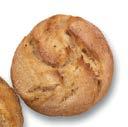


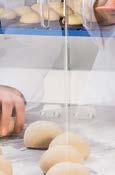



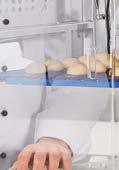


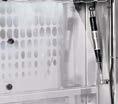
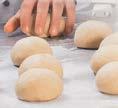
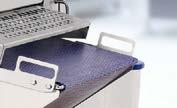




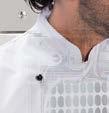



Top quality




































































































































































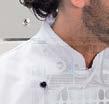

















































All sizes great and small.











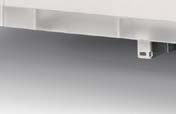


































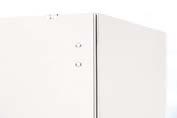
FRITSCH IMPRESSA bread – great-tasting, natural products with an artisanal look are no problem. Proven SoftProcessing technology guarantees exceptionally gentle processing of soft dough and allows high output and absolutely stable operation. For production of round-molded rolls – in all sizes from small rolls to large boules – the round molder for artisanal bread opens up virtually unlimited possibilities, so you can realize your great ideas. Find out more at www.fritsch-group.com






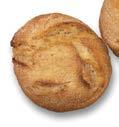




We look forward to welcoming you














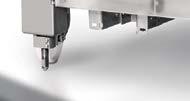








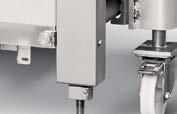

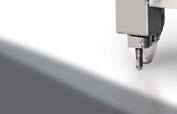











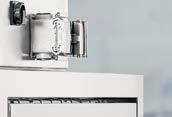

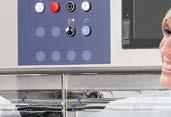



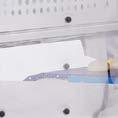
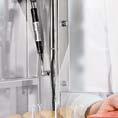









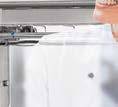
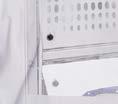










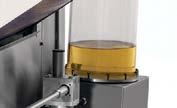






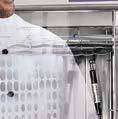

























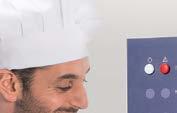







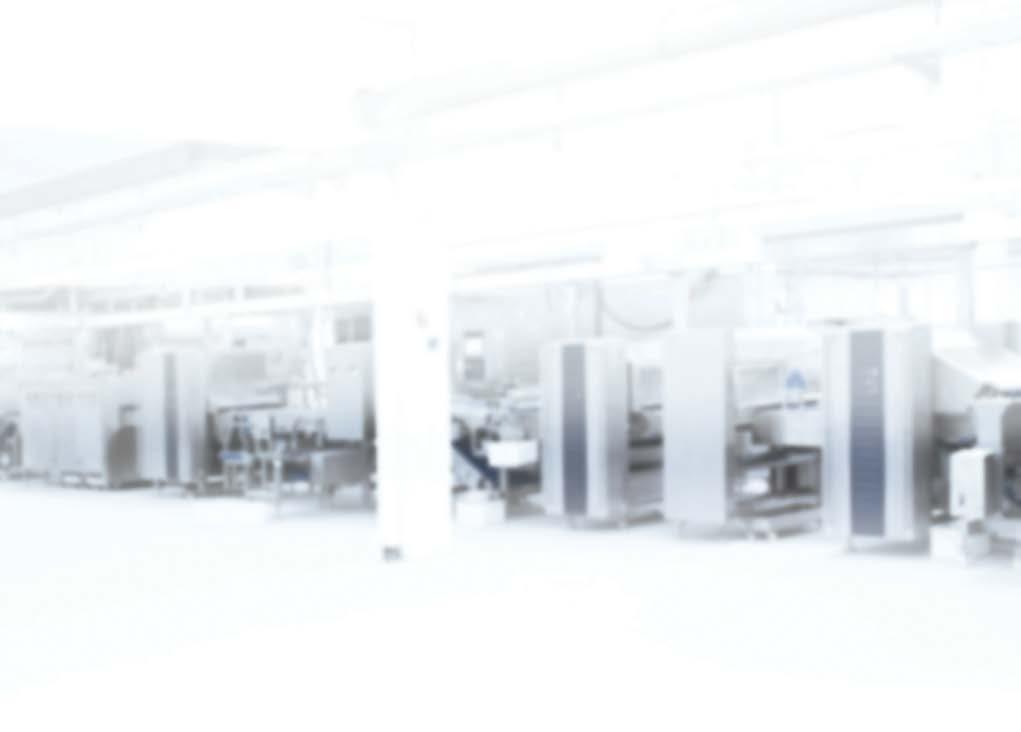
to our booth 5480.
Acrylamide in bakery wares
Since the discovery by Swedish scientists that acrylamide is formed during browning processes in foods containing starch, the industry and the Legislator must concern themselves with this topic, because acrylamide was and is classified as carcinogenic.
In a cooperation between industry, scientists and the authorities, signal values were developed in the following years. These were intended to oblige manufacturers to take action if they were exceeded, but said nothing about whether they were fit for human consumption. The German baking sector was able to deal with these signal values very well: there is no other product in which acrylamide levels are as low as they are in bread and baked goods.
The 2015 risk assessment
A new risk assessment by the European Food Safety Authority (EFSA) raised the stakes on the topic of acrylamide in the summer of 2015. EFSA, the EU’s highest body on food safety, now classified acrylamide as “potentially carcinogenic”. However, since there are no reliable human studies on the risk of cancer, EFSA applied the precautionary principle: acrylamide was to be handled in future according to the ALARA principle ( A s L ow A s R easonably A chievable).
Initially, this gave the EU Commission a reason for a further decrease in the signal values, which were to be reduced from 150 µg/kg for soft bread to 80 µg/kg across the board. This could have led to an increase in transgressions for rye baked products, which form more acrylamide than wheat products. The German Plant Bakers Association achieved a split of the values into 80 µg/kg for “Wheat-based soft bread” and 150 µg/kg for “Soft bread based on other types of cereals”.
However, consideration was also given to formulating a proper EU Regulation on acrylamide that would promote the systematic reduction of acrylamide and was intended to introduce a sampling regime for acrylamide. Until then, regulation took place based on EU Commission recommendations.
Regulation 2017/2158
After several draft versions, in part with considerable changes to their content, the “Commission Regulation (EU) 2017/2158 of 20th November 2017 establishing mitigation measures and benchmark levels for the reduction of the presence of acrylamide in food” was published in the EU Official Journal.
The Regulation is on the one hand a continuation of the Commission’s recommendations, but on the other it also contains new and hitherto unknown approaches.
The Regulation’s title already indicates that its topic relates to minimization measures for acrylamide and acrylamide guideline values. One point that is important in practice is not mentioned in the title, namely an obligation for the industry to take samples, analyze them and to record the results. This point has practical importance, because this obligation is
differentiated by the Legislator according to business size, and so are the minimization measures that are to be adopted. It can be roughly summarized thus: big businesses must do more. This differentiation is enshrined in Article 2 of the Regulation. A criticism that must already be raised at this point is that Article 2 is difficult to understand, and is hard to read due to numerous references to the Annexes. An even more serious problem, however, are the many undefined legal terms which Article 2 contains or to which it refers. The three Sections of the Article require the following comments:
Article 2, Paragraph 1
“Food business operators which produce and place on the market foodstuffs listed in Article 1(2) shall apply mitigation measures provided for in Annex I.”
Applicability: Effectively, this obligation applies to all companies except small artisan businesses, see further remarks on this subject below.
Obligations:
Essentially, this creates two groups of obligations:
1. Minimization/mitigation measures pursuant to Annex I of the Regulation must be checked and documented.
2. Sampling, analysis and recording must be carried out for this purpose (Annex III).
1. The first group of obligations in Annex I consists of minimization measures which the sectors compiled in so-called Codes of Practices at that time. The measures for Bread and Fine Bakery Wares are applicable to the baked goods sector.
In the case of minimization measures, a check must be made in the business as to whether these measures can or cannot be implemented. The main question that plays a role in this respect is whether there is a negative change in the organoleptic properties or required product design of the baked goods. For example, if in principle a bread can be less browned in order to generate less acrylamide, but the baker discovers that he is no longer able to obtain the product he wants to manufacture, there is no compulsion to carry out the measure.
Written records must be kept about all the minimization measures.
2. The second group of obligations (obligation to take samples, analyze and keep records) is comprehensively described in Article 4 and Annex III of the Regulation. It follows from this that food business operators must design and carry out their sample-taking and analysis programs on their own
www.bakingbiscuit.com 04/2019 FOOD LAW 54
+
responsibility. The samples being taken have to be representative and must represent the product types manufactured in the business operation. The business operator must decide exactly where the dividing line between different product types is to be drawn. The wording of the legislative text on this point is: “A ‘product type’ includes groups of products with the same or similar ingredients, recipe design, process design and/or process controls where these have a potential influence on acrylamide levels in the finished products.” Thus in concrete terms, the baker can also define similar products, e.g. various rye mixed breads, as a single product type and can sample them collectively.
As a basic principle when taking samples, the focus should be on products that have shown a potential to exceed the guideline values. Moreover, sampling should take place in a risk-based way, i.e. the food business operator can use his own risk assessment as the basis for the sampling and analysis plan for acrylamide. In the case of products with a known, well-controlled acrylamide content, samples should be taken once a year, and more often for products with the potential to exceed limits. (Annex III, Paragraph III.)

Finally, business operators have an obligation to make the results of the analyses available to the authorities every year “on request”. (Annex III, Paragraph V)
Article 2, Paragraph 3
“Food business operators referred to in paragraph 2 which operate in facilities under direct control and that are operating under one trademark or commercial license, as a part of, or franchise of, a larger, interconnected operation and under the instructions of the food business operator that centrally supplies the foodstuffs referred to in Article 1(2), shall apply additional mitigation measures set out in Part B of Annex II.”



Applicability: In the first place, without wanting to go too deeply into the complicated wording, it can be said that this Paragraph is intended to cover chain and franchise companies.
Obligations: The obligations applying to these business operations are the same as for operations under Article 2, Paragraph 1: checking and documenting minimization measures and the duty to keep records. There is an additional obligation to comply with Annex II, Part B. However, this Annex only says:




1. General requirement FBOs (Food Business Operators) shall accept products referred to in Article 1(2) only from FBOs that have implemented all mitigation measures set out in Annex I. (…)




3. Bakery products FBOs shall monitor the level of acrylamide in finished products to verify that the mitigation measures are effective in keeping acrylamide levels below the benchmark level.




















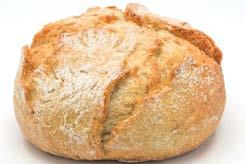




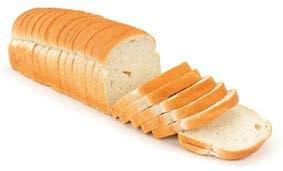
YOUR PRODUCT, OUR FOCUS!

TOTAL DOUGH HANDLING

55 FOOD LAW ADVERTISEMENT
Buns and Rolls Pan bread
Newcap Bakery Services BV The Netherlands www.newcapbs.com
BVT Bakery Services BV The Netherlands www.bvtbs.com
Artisan bread
BOOTH 7189
It remains open how Point 1 is to be monitored. Acrylamide content monitoring as required in Point 3 already takes place according to the obligation groups mentioned above, so there are doubts as to which new duties Annex II, Part B is intended to contribute.
Article 2, Paragraph 2
“By way of derogation from paragraph 1, food business operators producing foodstuffs listed in Article 1(2), which perform retail activities, and/or directly supply only local retail establishments shall apply mitigation measures provided for in Part A of Annex II.”
This ruling affects small artisan businesses. (fordifferenciation, see below)
Obligations:
1. Minimization measures according to Annex II, Part A This contains a catalogue of minimization measures that is more restricted compared to Annex I, but which overlaps with the latter in many respects. In particular, the maintenance of product quality is of topmost priority here again, and is a precondition for introducing minimization measures.
2. Restricted documentation of minimization measures
According to Article 4, Paragraph 6, small businesses need only be in a position to produce documentary proofs of these minimization measures, but need not carry out thorough documentation. There is no duty to take and analyze samples.
Differenciation
In particular, the exact differenciation between small artisan businesses and the other businesses mentioned in Article 2 is difficult in practice. This is mainly due to the fact that the Legislator has not described exactly which businesses belong to one category or to the other. All that is certain is the Legislator’s wish not to impose disproportionately large monitoring burdens on small businesses.
For this reason, immediately after the Regulation was published, the Commission prepared a so-called Guidance (“Guideline”). This Guideline interprets the Regulation, but without itselfbeing legally binding, and the measures are noncommittal. Nevertheless, in practice many administrative bodies and businesses will align themselves to these measures.
The Guidance mentions numerous possible criteriae to differentiate between “small” and “large” business operations:
+ The EU SME definition
Small and medium-sized enterprises (SMEs / micro and small enterprises) should be included among companies in accordance with Article 2, Paragraph 2. According to EU Commission Recommendation 2003/361, a company is an SME if it employs fewer than 250 (not more than 249) persons and has an annual turnover not exceeding EUR 50 million and/or an annual balance sheet total not exceeding EUR 43 million.
+ “Local” businesses
The definition of exactly what constitutes a local business
is supposed to be specified at national level, but a catchment area of 100 km is suggested as a possible indication.
+ Additional criteriae include the ratio between turnover in consumer business and delivery to other local businesses, only occasional/seasonal supplying, the number of local businesses supplied to, and other criteria which the competent authorities consider to be relevant.
+ Membership of an association
The sector’s membership in a particular European sector association is also seen as a possible classification indicator. However, this criterion has so little discriminatory power that its validity must be called into doubt. An example is the German Plant Bakers Association: it is represented on EU level via the AIBI, the International Association of Plant Bakers. AIBI members are in turn classified in the Guidance among the businesses that are in accordance with Article 2, Paragraph 1. However, the German Plant Bakers Association also represents numerous branch bakeries of various sizes whose allocation to Article 2, Paragraph 1 is not self-evident. Paragraph 3 or Paragraph 2 may also be applicable to these businesses, depending on their size and organization form. On the other hand, no bakery business that can be classified as a chain or franchise business is represented in the Association Serving Europe, which is allegedly definitive for Paragraph 3.
Guidance values
When dealing with the Acrylamide Regulation, an understanding of the guidance values for acrylamide is of decisive importance. The following guidance values are defined in the Regulation:
Soft bread µg/kg
a) Wheat-based bread 50
b) Soft bread other than wheat-based bread 100
Cookies and waffles/wafers 350 Crackers, except potato-based crackers 400 Crispbread 350 Lebkuchen 800 Products similar to other products in this category 300
Analytical methods
Regarding the level of the guidance values it may be noted that it is questionable whether, at least in the case of “wheat-based bread”, th low value of 50 µg/kg makes sense in practicesince it is already close to the analytical detection limit. Although modern analytical methods are technically able to measure values of 10 µg of acrylamide, the measurement inaccuracy in this region is very large, and thus the occurrence of false positive findings is likely. Due to this uncertainty, as a rule even the Max-Rubner-Institute 1 does not take any account of measured values below 50 µg/kg. Many quality assurance
www.bakingbiscuit.com 04/2019 FOOD LAW 56
1 Max-Rubner-Institute (MRI), the scientific body advising the German Federal Ministry of Agriculture and Consumer Protection.
departments in bakeries even state that a considerable proportion of the positive analyses above 50 µg/kg are attributable to measurement inaccuracies and fluctuations in sample preparation.
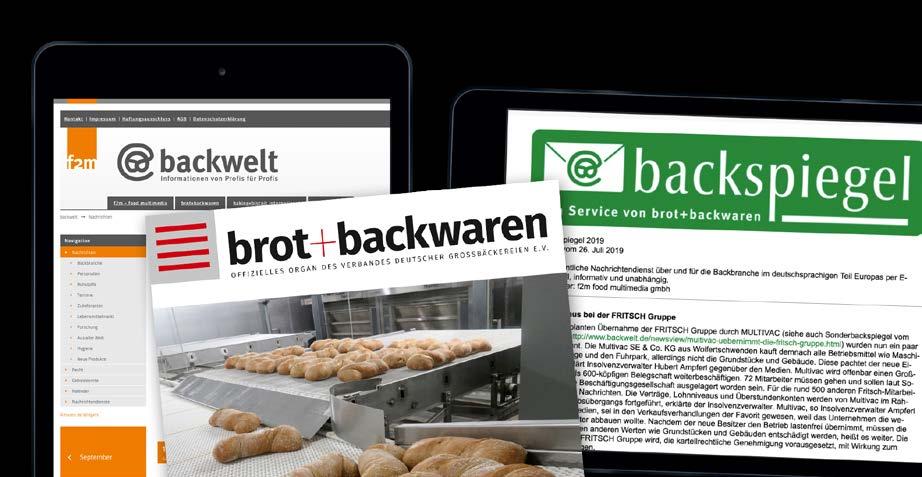
Significance of the Guidance Values
The Legislator has stressed on several occasions, in both the legislative text and in the Guidance, that the Guidance Values – like the signal values that previously existed – are not legal limits / maximum values. Thus the Definition of Terms in Article 3, Paragraph 2 says:
“ ‘Benchmark levels’ means performance indicators used to verify the effectiveness of the mitigation measures and are based on experience and the occurrence of acrylamide in broad food categories.”
The context is stated in even greater detail in Recital 10 of the Regulation:
“It is acknowledged that the specified food categories are in certain cases broad and that for specific foods within such a broad food category there may be specific production, geographic or seasonal conditions or product characteristics for which it is not possible to achieve the benchmark levels despite the application of all mitigation measures. In such situations, the food business operator should be able to show the evidence that he applied the relevant mitigation measures.”
Thus an exceedance of Guidance Values does not in any way result in a product becoming unmarketable, but initially only triggers further obligations to investigate, and to provide proof if necessary.
Guidance Values as “quasi-legal limits”: an aberration
A regrettable trend in recent years is that stakeholders in both the food retail and consumer protection organizations tend to regard signal and guidance values as “quasi-legal limits”. Transgression can then lead to delisting in retail, or to downgrading in the context of product tests in the case of consumer protection groups. Neither of these is appropriate, since the guidance values – as explained above – say nothing about the quality or health acceptability of a food. Nevertheless, this emphasizes the great practical importance of appropriate guidance values forbakery wares.
Classification of specific products
Firstly, the Acrylamide Regulation creates “roughly defined” product groups in the baked goods area (e.g. “Soft Bread”), but secondly goes into great detail for certain baked products (e.g. Crispbread or Lebkuchen ). In view of the great diversity of products, especially in the range of German baked goods, the question that arises repeatedly is where any given bakery wares are to be classified in this system. The following legal sources may play a role in this respect:
57 FOOD LAW ADVERTISEMENT
You want to find a German Baker? … try our job classifieds –print and online! Please contact:
The text of the Regulation
In the first place, the Regulation itself can be consulted with regard to classification. For example, the relatively broad product group comprising “Soft wheat-based bread” covers the lion’s share of these baked goods, but, as already mentioned, the descriptions “Cookies and waffles/wafers”, “Crackers”, “Crispbread” or “ Lebkuchen ” are very specific.
Guidance
The content of the above-mentioned Guidance accompanying the Acrylamide Regulation is also important. At least a few indications about the possible interpretation of the product groups are given here. Pumpernickel 2 may be quoted as an important example in this respect. According to the first draft version of the Guidance , this was still said to be classifiable as “Soft bread”. After an intervention by our association, it has now received its own guidance value of 300 µg/kg, which allows sufficient latitude for this special product.
Monitoring recommendation
Finally, after the release of the Guidance , the Commission formulated a Draft Commission Recommendation regarding the monitoring of acrylamide in certain foods (Document SANTÉ/10710/2018). This draft has direct effects on the understanding of the Guidance Value. However, at the time of publication it was available only as a draft version in English and not in other languages.
In its Annex, the draft recommendation names certain foods for which it was not yet possible to specify an acrylamide guidance value due to the lack of a sufficient data base. The Commission recommends these foods for monitoring by the authorities and industry. The Annex includes the following products in the Baked Goods area:
Bakery products (Baked goods)
+ Rolls (hamburger rolls, whole wheat rolls, milk rolls, …)
+ Pita bread, Mexican tortillas
+ Croissants
+ Doughnuts
+ Specialty bread (such as pumpernickel bread, ciabatta with olives, onion bread, ….)
+ Pancakes
+ Crisp cookies from a thin strip of dough and deep fried
+ Churros
This Draft Recommendation requires several comments:
1. No guidance values for products in the monitoring document The German Federal Ministry for Food and Agriculture (BMEL) has made it clear that the products named in the Monitoring Recommendation are currently not subject to any guidance
value for acrylamide. Dr. Annette Rexroth, responsible in the Ministry for the subject of acrylamide, formulated this as follows in a letter accompanying the Monitoring Recommendation:
“Currently, the question remains open which guidance values are to be specified for these products in the future. Therefore, the guidance values in Annex IV of Regulation (EU) 2017/2158 should not apply to the foods named in the Recommendation. I have notified the competent authorities in the German Länder (federal states) accordingly.”
In the opinion of the German Plant Bakers Association, this legal view is appropriate and welcome indeed. Temporarily excluding from the guidance value regime product groups that remain unclear defuses the somewhat heated debate about the “true” guidance value. Simultaneously, it gives industry and state institutions time to collect more data on the basis of which to define a guidance value that can be complied with in practice.
2. Bread rolls
With this in mind, it is logical that the bread rolls product group in its entirety is subject to the Recommendation, and thus not to the Regulation’s guidance values. This was previously not the case: the Acrylamide Recommendations lumped bread and rolls together in a single product group. That is inappropriate, because although bread rolls are similar to bread in many respects, they have a considerably larger specific surface. The surface of rolls is where the greatest formation of acrylamide takes place. Therefore there is a need to check whether more latitude is needed for bread rolls of all kinds.
3. “Specialty Bread”
The sheer endless variety of bread products is taken into account by including Specialty breads in the Monitoring Recommendation. This creates an opportunity to establish clarity for all products outside of the special categories named by the Regulation itself, without for the time being any need to fear the Damocles sword of an unclear guidance value assignment. Bakeries should use this opportunity, and should build up series of analyses for baked goods suspected of forming more acrylamide.
4. Sampling croissants and doughnuts is unnecessary
Finally, it is not comprehensible why the Commission includes croissants and doughnuts in the product group for monitoring, since the unanimous experience among bakers is that these two products have never yet been susceptible to acrylamide formation. The German Plant Bakers Association explicitly opposed this inclusion, both in relation to formulating the Guidance and regarding this Recommendation, but was ignored up to now. In our view, sampling these two products is unnecessary and generates superfluous costs.
Whether the present draft of the Monitoring Recommendation for acrylamide will undergo further changes remains to be seen.
www.bakingbiscuit.com 04/2019 FOOD LAW 58
2Pumpernickel is a German bread speciality made exclusively from wholemeal rye products which is baked for at least 16 hours at high humidity and low temperatures.
Legal limits for “baby food”
In February 2019, the “Working Group on Environmental and Industrial Contaminants in Food” of the Standing Committee on Plants, Animals, Food and Feed (PAFF Committee) discussed initial proposals for maximum levels of acrylamide in foods for infants and young children. The consultation paper contains proposals for maximum acrylamide levels in biscuits and rusks for infants and young children (150 μg/kg) and in baby foods, processed cereal based foods for infants and young children excluding biscuits and rusks (50 μg/kg). Thus “real” legal limits for acrylamide are being discussed, albeit only in the limited area of foods for infants and young children.
Summary and outlook
Although the Legislator has now issued a Regulation, this is by no means a satisfactory solution for the subject of acrylamide. This is for several reasons.Firstly, the Regulation itself is complicated and partially not very clearly worded, whereupon the Commission found itself compelled to tack on a Guidance as an interpretation aid. By doing this, the Commission followed the bad example of other Regulations which, as it were, had to be explained by an Appendix and “somehow” made fit for purpose. This is not only poor legislative drafting, but also creates legal uncertainty which is hard to endure, because everyone who is subject to the legislation – bakers just as much as the food supervision agency – must gather together the truth for themselves between the law and the interpretation aids. Consequently, this solves neither the
Author
Alexander Meyer-Kretschmer, Attorney-at-Law, Managing Director of the German Plant Bakers Association, focusing on food law meyer-kretschmer@grossbaecker.de
question of who must take acrylamide samples and how many, nor the question as to which baked products are subject to which guidance values. Admittedly: both sets of questions have a variance range and need a certain amount of practical leeway, but slightly more orientation from the Legislator would have been desirable. After all, it involves considerable commercial expenses (analysis costs, reference value categorization, risk of delisting/downgrading).
The criteriae by which the Legislator will shape the next act in the acrylamide drama remain to be seen, namely establishing “real” legal limits. This has been scheduled for the period after the next Review, i.e. the next revision of the Acrylamide Regulation in about 2 years. Against this background, it is extremely important for industry to collect analysis data, especially in the case of products whose acrylamide content has still not yet undergone much research. As far as possible, these results should be collected together in a monitoring exercise throughout the sector, to be able to join forces politically to push through guidance values that are appropriate in actual practice. +++
Trade fair calendar 2019
September 7-11, 2019
Las Vegas/USA
IBIE – International Baking Industry Exposition
www.ibie2019.com
September 13-16, 2019
Tehran/Iran
IBEX 2019 – Int`l Grain Flour & Bakery Industry Exhibition
www.ibex-en.com
September 21-24, 2019
Stuttgart/Germany
südback – Trade fair for the bakery and confectionery trades www.messe-stuttgart.de/suedback/en
September 24-26, 2019
Nuremberg/Germany
FachPack – European Trade Fair for Packaging, Processing and Technology www.fachpack.de/en
October 5-9, 2019
Cologne/Germany
Anuga 2019 (including Anuga Bread & Bakery) www.anuga.com
November 1-3, 2019
Birmingham/UK
Cake International - The Sugarcraft, Cake Decorating & Baking Show www.cakeinternational.co.uk
November 16-19, 2019
Rimini/Italy
FoodNova – Gluten Free Expo, Lactose Free Expo, Expo Veg and Ethnic Food Expo www.foodnova.eu
December 3-5, 2019
Paris/France
Fi Europe – Food Ingredients Europe www.figlobal.com/fieurope
December 9-11, 2019
Cairo/Egypt
FoodAfrica 2019
www.foodafrica-expo.com

59 FOOD LAW www.bakingbiscuit.com 04/2019
© rclassenlayouts –123rf.com
You bake, we care
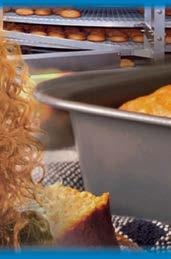

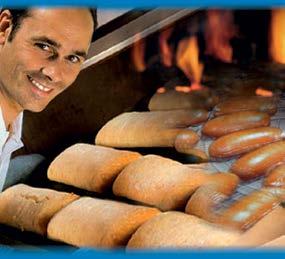
TurnKey Concept
 1/1 Kaak
1/1 Kaak
FROM SILO TO TRUCK
Kaak FPS | Kaak Bakeware | Benier | DrieM | Daub | MCS | LhotellierR2A | Multiparts








 Bastian Borchfeld
Bastian Borchfeld


















































































































































































































































 BY READING BAKERY SYSTEMS
BY READING BAKERY SYSTEMS
































































































































































































































































































































































 1/1 Kaak
1/1 Kaak